Lillooet - Pleasantville in Technicolor
Saturday, May 31, 2008

Looking at Ale (left), now 39, playing with Lauren and Rebecca out in her Lillooet back yard I find it almost impossible to believe but I also find myself lucky to be able to enjoy it. In particular, today, while Rebecca and I were both seeing Pleasantville for a second time, Ale and Lauren were bonding outside with the help of a hose and nozzle.
Even though the drive is not an easy one the next day (today) seems almost like a real live Pleasantville, a Pleasantville in Technicolor. Sounds, smells, tastes and colours are enhanced. Rosemary almost relaxes and I have my two granddaughters all to myself without the hindrance of their parents!
We visited Lloyd McNary's (79) farm today (photos will follow during the week). The girls rode a beautiful horse, bareback and we finished off the stay with McNary's fruit compote and yoghurt ice cream. We then dropped in on Teresa Scallon and Zane Spencer's mountain retreat (very near MacNary's) complete with waterfall and vegetable garden. Lauren and Rebecca rolled down their grass hill while we watched a view to die for.
A cheese fondue will be our dinner (we even brought the Kirsch) and in the morning I will be making extra think pancakes (not crepes, just thin pancakes). We have an unopened container of Argentine dulce de leche which we will slather on those pancakes. I never ask where's my dinner. If I don't cook it, there is no dinner. Since I came to understand this some years life has been less stressful. Besides I like my own cooking.
The Blood Mixes Inside My Heart At The Kay Meek Centre
Friday, May 30, 2008
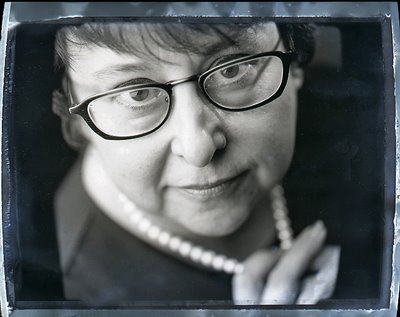
Last year Harvard architect Abraham Rogatnick and I parked our car on 17th Street in West Vancouver. It was in the evening and we walked up to the place where we were going to see an advance performance of Lloyd Burritt's opera Dream Healer. The place was called the Key Meek Centre. Somehow this venue had sprung on us like a newborn baby from nowhere. It was up on the mountain. Jutting out were three flying saucer-like structures of metal and glass. We were awed. We immediately inquired and found out that the architects involved, Richard Iredale and James Emery, had an interesting connection with the city below. It was Iredale's father, Rand Iredale who had built the arresting West Coast Transmission building on West Georgia.
In the lobby there was a colourful portrait of Kay Meek. We were told she wanted a theatre in West Vancouver so she donated one million dollars. By building the structure next to a school the city donated the land. It was only last night that, off the record, I was told that Kay Meek's money came through her husband's involvement in rum running.
Last night Rosemary and I attended an unusual theatrical performance at the Key Meek Centre. In preparation to taking the play, Where the Blood Mixes (written by young Nlakapmux playwright Kevin Loring) to a Toronto theatre festival the Playhouse Theatre Company was persuaded to mount a production in West Vancouver.
The play with its background of alcholism and Catholic boarding school abuse in Lytton specially hit home. Today we drive through Lytton to visit our daughter in Lillooet. We will drive across the very bridge that is central to this poignant play about a father (Floyd, played by Billy Merasty) being found by his daughter (Christine, played by Quelemia Sparrow) who was taken away by "the ministry" when her mother died of mysterious and tragic consequences. Most of the action happens in the bar of the Lytton Hotel that is presided by the benevolent bar man George, Tom McBeath who has a kind soft spot and is unable to prevent Floyd's friend, Mooch (Ben Cardinal) from spending his wife's (June, Margot Kane) money on booze.
This play made Rosemary and I laugh even though the tragedy on stage was ever present. Ben Cardinal's performance of the ever drunk Mooch was so convincing I was worried he would fall from the stage on to the confluence of the Thompson and the Fraser Rivers below. It was almost hard for me to believe that the kind (in my studio!) Margo Kane could be so brutal with Mooch. But it was Billy Merasty's voice and slight Irish accent (learned from a school in Northern Manitoba, perhaps?) that enveloped me and charmed me. I hope to see more of this actor soon. His breaking down on his daughter Christine's lap just about made me cry.
The whole play had the constant and unobtrusive playing of Jason Burnstick's guitar and weissenborn lap slide playing and singing. But it was the sweet tone of his Haida Gwaii made guitar that really made me notice. I had to, after the play ended, ask Burnstick to show me the instrument. This he did.
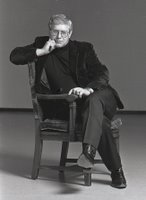
I found it almost symmetrical for me to see Playhouse Director Glynis Leyshon (above left) direct her, perhaps, last play as she moves on. I first photographed her in my studio in Februrary 1997 when she had just arrived to town. Even then I had the fond but confused (had I been afraid of the man as he had posed for me?) memory of having photographed another Playhouse director, Walter Learning (right) sometime in the end of the 70s.
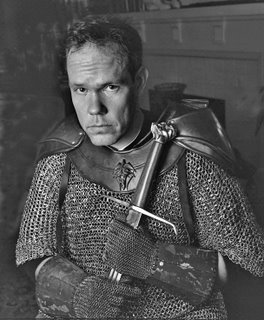
The play has an important bar brawl and I was surprised to find out that the fight choreographer, Nicholas Harrison (right) managed without broadswords and dirks.
As we left I had a short chat with Margo Kane (below) and she told me she sort of enjoyed "slapping" Mooch. I looked at her warm smile and I didn't believe a word of it.
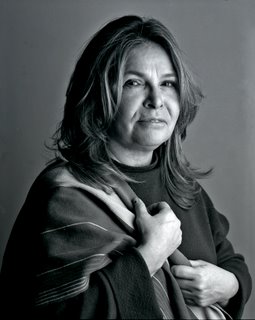
Today as we cross the bridge in Lytton I will no longer think that the old Nativfe name for the place, Kumsheen, does not mean "the place where the Rivers meet" but in reality the far more poetic "the place inside the heart where the blood mixes".
This play most surely did that. There are still two more performances of this play to be held at the Key Meek Centre.
Yuliya In The Garden - Jo-Ann In My Studio
Thursday, May 29, 2008

I have written about Jo-Ann and Yuliya here and about Yuliya here. Now I have the opportunity to show some of their latest pictures. They pass my self-imposed modesty standard of no nudes in my blog. As some of my students at Focal Point would say, "They are nudes but the bits and pieces don't show."
Yuliya showed up on Tuesday and it was a cloudy day with nice shades of green since there was no contrast. This inside shot by my computer would have been impossible on a sunny day as the contrast difference between the living room and the garden would have exceeded my film's range.
With Jo-Ann at our last studio session I used an old Hollywood light that was given to me by photographer Brent Daniels some 16 years ago before he left for Toronto. The light has a huge two foot long incandescent light bulb. Daniels subsequently moved to Australia and can be found here.
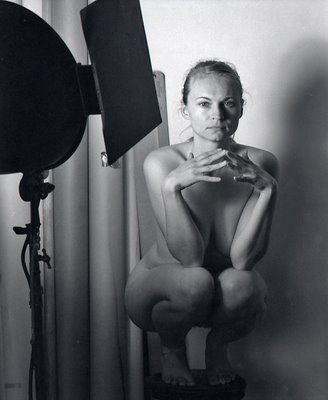
It is liberating to photograph Yuliya in the garden without lights and to use no flash with Jo-Ann. It makes me feel like I am back to my original roots, before I could afford a studio flash system. The studio flash is so easy to use that after a while I feel like I am in a rut. There is a challenge in having to fight contrast and the unpredictability of anything that is not my set formula.
Now if I could only be in Mexico City on a hot day and be able to tell Yuliya or Jo-Ann, "Let's go to the azotea and take some pictures!
Wednesday, May 28, 2008
Someone jolted my elbow as I drank and said, "Je vous demande pardon," and as I moved to give him space he turned and stared at me and I at him, and I realized, with a strange sense of shock and fear and nausea all combined, that his face and voice were known to me too well.
I was looking at myself.
The Scapegoat, 1956, Daphne Du Maurier

Every once in a while my writer friend Sean Rossiter, left, calls me up to meet him with some friends for lunch downtown. He usually invites a writer from the Vancouver Sun, Nick Rebalksi, an architect, Alan James and some surprise guest. The connection here is that somehow this trio lived in the same neighbourhood and have an interest in golf, hockey and English cars. I like going because this is the closest to the Spanish concept of a tertulia where friends meet at a cafe to discuss politics, football (soccer) and life.
It was at one of the restaurants where I met up with Rossiter some years ago that I noticed on a wall of decorative Book-of-the-Month Club books, Daphne Du Maurier's The Scapegoat. I had a cheesy (the cover) pocket book version of this terrific book at home. I read it once a year in conjunction with Du Maurier's House on the Strand. And only a week ago I was finally able to see the noir/gothic film version of The Scapegoat on the Turner Classic Movies channel. Consider that this film has Alec Guiness and Bette Davis. Until recently this film was out of print.
When I saw that pristine but worthless (all BOTMC books are worthless) The Scapegoat I longed to liberate it from the tragic oblivion of, perhaps, never having been read. Books have to be read and should never be used for purely decorative reasons. I wrestled in my mind trying to rationalize my potential petty theft. In the end I liberated it and took it home, warmly held under my arm. The cheesy pocketbook version I gave to my daughter Ale and my worthless edition is proudly displayed in my living room library.
A week ago when Rosemary and I went to see The Producers I ran into author/actor C.C. Humphreys who excitedly told me, "After your recommendation I found a cheap pocket book version, with a chessy cover of The Scapegoat at a used book bin. It is terrific."
Could it be that one wrong makes a few rights?
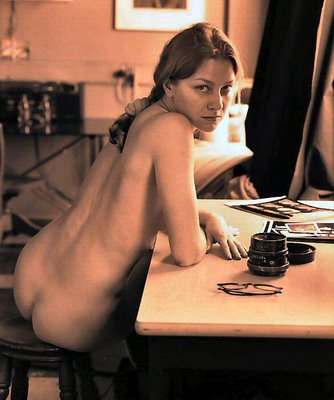
Today I teach the 8th session (a 10 week, every Tuesday course) of my contemporary portrait nude at Focal Point. One of our models is the most interesting and expressive Yuliya who hails originally from Ukraine. She indicated she also wanted me to photograph her in an outdoor or garden session. I have done this sort of thing in my past and I find it difficult to find some way of doing it differently. She will be here at 10 and we will leave for Focal Point at 1:00pm. I have no idea if I will be inspired nor do I know if I will have any results. The cloudy weather is a perfect low contrast situation for both nudes and garden photographs. I will make sure that I do take some pictures that I will be able to post here!
Someone jolted my elbow as I drank and said, "Je vous demande pardon," and as I moved to give him space he turned and stared at me and I at him, and I realized, with a strange sense of shock and fear and nausea all combined, that his face and voice were known to me too well.
I was looking at myself.
The Scapegoat, 1956, Daphne Du Maurier

Every once in a while my writer friend Sean Rossiter, left, calls me up to meet him with some friends for lunch downtown. He usually invites a writer from the Vancouver Sun, Nick Rebalksi, an architect, Alan James and some surprise guest. The connection here is that somehow this trio lived in the same neighbourhood and have an interest in golf, hockey and English cars. I like going because this is the closest to the Spanish concept of a tertulia where friends meet at a cafe to discuss politics, football (soccer) and life.
It was at one of the restaurants where I met up with Rossiter some years ago that I noticed on a wall of decorative Book-of-the-Month Club books, Daphne Du Maurier's The Scapegoat. I had a cheesy (the cover) pocket book version of this terrific book at home. I read it once a year in conjunction with Du Maurier's House on the Strand. And only a week ago I was finally able to see the noir/gothic film version of The Scapegoat on the Turner Classic Movies channel. Consider that this film has Alec Guiness and Bette Davis. Until recently this film was out of print.
When I saw that pristine but worthless (all BOTMC books are worthless) The Scapegoat I longed to liberate it from the tragic oblivion of, perhaps, never having been read. Books have to be read and should never be used for purely decorative reasons. I wrestled in my mind trying to rationalize my potential petty theft. In the end I liberated it and took it home, warmly held under my arm. The cheesy pocketbook version I gave to my daughter Ale and my worthless edition is proudly displayed in my living room library.
A week ago when Rosemary and I went to see The Producers I ran into author/actor C.C. Humphreys who excitedly told me, "After your recommendation I found a cheap pocket book version, with a chessy cover of The Scapegoat at a used book bin. It is terrific."
Could it be that one wrong makes a few rights?
Yuliya In The Garden
Tuesday, May 27, 2008

Today I teach the 8th session (a 10 week, every Tuesday course) of my contemporary portrait nude at Focal Point. One of our models is the most interesting and expressive Yuliya who hails originally from Ukraine. She indicated she also wanted me to photograph her in an outdoor or garden session. I have done this sort of thing in my past and I find it difficult to find some way of doing it differently. She will be here at 10 and we will leave for Focal Point at 1:00pm. I have no idea if I will be inspired nor do I know if I will have any results. The cloudy weather is a perfect low contrast situation for both nudes and garden photographs. I will make sure that I do take some pictures that I will be able to post here!
Monday, May 26, 2008
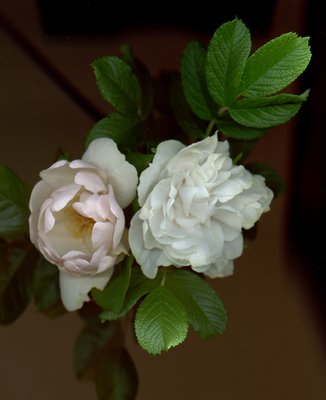
On the 24th of May I realized that I had one open rose in the garden. Every year Rosa 'Jacqueline du Pré' and Rosa 'Blanc double de Coubert' vie for being the first rose of our garden. I noticed that Blanc double de Coubert had lots of buds on Saturday but Jacqueline du Pré's lonely open flower on the same day trumped my ever hardy rugosa (notice the rugose crinkles of the leaves). Both roses are supposed to be white although Jacqueline does have a slight pink tint. Jacqueline is fragrant, delicately and demurely so. She cannot compete with the more intense Blanc double de Coubert.
It is only today, May 26 that I remember that yesterday was the anniversary of Argentina's independence (declared on 25 May, 1810, but the struglle lasted until July 9, 1816). Napoleon had invaded Spain so the residents of what was to be Argentina declared they did not recognize the authority of the Spanish viceroy. I remember fondly the date because I did not go to school and sometimes my father took me to see the desfile or military parade with strutting Argentine soldiers in their uniforms that were virtually indentical to the Wermacht of WWII. There were Sherman tanks and overhead we could hear the jet engines of Peron's Argentine jet fighter the Pulqui 1 and in later years of the Pulqui 2. I was much too young to disavow blatant militarism and it was most thrilling to me to hear the tank track noises and the singing of the Argentine national anthem.
It is perhaps appropriate that the 25 of May now is a competition between two white roses in my garden. But suppressed in me is the thrill of those military parades and the comforting security of holding my father's hand.

The Ballet BC House and Garden Tour was over by 5 pm today. Rosemary and I lingered on after with a young couple that had come all the way from Port Coquitlam. We saw them as ourselves 37 years ago when we lived in Burnaby. Unsaid between us was the depression we knew would set in as soon as they left.
In December 2005 I had the best one-man photographic show I have ever had. I even sold stuff. The show featured pictures of Rebecca, nude photographs of a beautiful one-armed model and very large giclées made from my flower scans. After having had many openings I was not ready then nor was I ready today to brush off the post show depression (be it a photographic opening or a gaden opening). People come and you enthusiastically answer their questions.
This post show depression is so acute (they say Diane Arbus slit her wrists in her tub the day after an opening) that years back I invented what I call pre-post-show-opening depression. I feel sad as soon as I hang the pictures on the wall, or in the case of our garden, just thinking about the opening days before.
The lawn has been trampled by the 1000 plus people that visited us in two days. Paradoxically I believe the lawn will come back in full force as the spongy nature of many of my turf repairs were flattened by feet and the ground was dried out (after the many days of rain or my perhaps unitelligent watering).
I understand our depression. People tell us as they leave, "Thank you so much for sharing your garden." It occurs to me that a garden is not a garden if it is not shared. A garden without visitors is silent in a sad way. I remember their eager questions and the smiles on their faces as I held up a cut rose for them to smell, Rosa 'Blanc Double de Coubert' which is always the first to bloom in our garden.
When I look at this self-portrait of Rebecca and I, taken after the 2005 opening I re live that show depression. I compensate by smiling as I think of her climbing the flowering cherry tree in our back yard as she did today. She asked me, "Papi do you think you could build me a tree fort?" I wonder if it is too late. She is 10. Will she discover boys in a few months and lose interest? Should I build it anyway for Lauren?

It was a long day in the garden and hundreds marched through the garden. Rosemary and I answered many questions to these visitors on the Ballet BC Home And Gardne Tour. They were an appreciative bunch but we felt exhausted by the end of the day. The weather permitted Rebecca and Lauren to run around barefoot. The visitors were all gone and I sat down in one of the adirondacks. The garden was beautiful in the late afternoon light. Lauren appeared with a plate of fruit and sat down next to me. "Why is your mouth so red, Lauren? You look like a vampire." "Papi, they are red because I have been sucking on strawberries."
A perfect ending to a perfect day.

It is almost 11:30 pm on Friday so this means that I will still be able to keep my pace of the daily blog. It is only now after a long day in the garden (and then shopping with Rosemary at Safeway) that I can finally sit down to write.
A few days ago I received an email communication through my web page from Ilse Taylor Hable. She and her husband Andrew live in Guadalajara. Yorkshire born Andrew is my eldest daughter Ale's godson. Ilse is Austrian and a very fine painter. I long to visit the Taylors at their home and have Rebecca learn painting from her.
name: Ilse Taylor Hable
comments: Dear Alex,
I´d love to see your famous garden one day!
Does it look shoulder to shoulder now that the date
has almost arrived? With so much care and love put
into it, I bet it´s a work of art.
Ilse
Well as the first picture here shows (I took in on Tuesday) one of my hosta beds is almost shoulder to shoulder as the plants lean on each other and dirt does not show. But there is no colour yet except for that Rhododendron luteum on the right. The yellow flowers have been perfuming the garden for a week. The roses all have buds. The many visitors to our garden tomorrow and Sunday may see the odd rose in bloom but not too much else. May 24 is a bit early for our garden and spring has been cold and wet.

The second photograph, which I took in June 2001 shows the riot of colour. The hosta with the mauve flowers is Hosta 'June'. June can be seen in the first photograph, too.
In the third photo there are remnants of the cherry blossoms. Besides finishing the hedge and doing other stuff I spent many hours with a hose set at a very fine spray and with my fingers I gently wiped away the blossoms from the many hostas under the cherry tree. Getting out of the car after our shopping I realized my back hurt, my legs hurt, my ankles hurt, my hands hurt and just about everything else! Tonight will be a pleasant relaxed sleep as there is not much more I can do. The garden is set for tomorrow. But I suspect that Rosemary will get up at 6:30 and with paint bucket in on hand and a painbrush in the other she will be painting the board (black) that runs the length of our white picket fence.
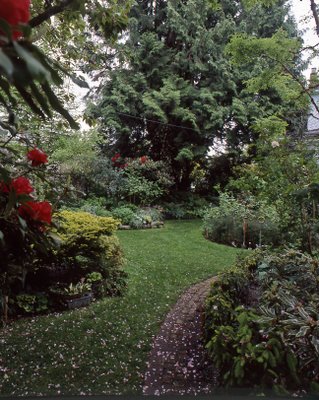
Ilse Taylor has a beautiful blog in which she writes (almost every day) on the meaning of colour in her painting. She also writes a bit on the origins of some of the colours. But best of all you get a sampling of the ethnic Mexico she likes to write about and paint. My favourite is the one on black pottery. Here it is.

On the 24th of May I realized that I had one open rose in the garden. Every year Rosa 'Jacqueline du Pré' and Rosa 'Blanc double de Coubert' vie for being the first rose of our garden. I noticed that Blanc double de Coubert had lots of buds on Saturday but Jacqueline du Pré's lonely open flower on the same day trumped my ever hardy rugosa (notice the rugose crinkles of the leaves). Both roses are supposed to be white although Jacqueline does have a slight pink tint. Jacqueline is fragrant, delicately and demurely so. She cannot compete with the more intense Blanc double de Coubert.
It is only today, May 26 that I remember that yesterday was the anniversary of Argentina's independence (declared on 25 May, 1810, but the struglle lasted until July 9, 1816). Napoleon had invaded Spain so the residents of what was to be Argentina declared they did not recognize the authority of the Spanish viceroy. I remember fondly the date because I did not go to school and sometimes my father took me to see the desfile or military parade with strutting Argentine soldiers in their uniforms that were virtually indentical to the Wermacht of WWII. There were Sherman tanks and overhead we could hear the jet engines of Peron's Argentine jet fighter the Pulqui 1 and in later years of the Pulqui 2. I was much too young to disavow blatant militarism and it was most thrilling to me to hear the tank track noises and the singing of the Argentine national anthem.
It is perhaps appropriate that the 25 of May now is a competition between two white roses in my garden. But suppressed in me is the thrill of those military parades and the comforting security of holding my father's hand.
Pre-Post-Show Depression
Sunday, May 25, 2008

The Ballet BC House and Garden Tour was over by 5 pm today. Rosemary and I lingered on after with a young couple that had come all the way from Port Coquitlam. We saw them as ourselves 37 years ago when we lived in Burnaby. Unsaid between us was the depression we knew would set in as soon as they left.
In December 2005 I had the best one-man photographic show I have ever had. I even sold stuff. The show featured pictures of Rebecca, nude photographs of a beautiful one-armed model and very large giclées made from my flower scans. After having had many openings I was not ready then nor was I ready today to brush off the post show depression (be it a photographic opening or a gaden opening). People come and you enthusiastically answer their questions.
This post show depression is so acute (they say Diane Arbus slit her wrists in her tub the day after an opening) that years back I invented what I call pre-post-show-opening depression. I feel sad as soon as I hang the pictures on the wall, or in the case of our garden, just thinking about the opening days before.
The lawn has been trampled by the 1000 plus people that visited us in two days. Paradoxically I believe the lawn will come back in full force as the spongy nature of many of my turf repairs were flattened by feet and the ground was dried out (after the many days of rain or my perhaps unitelligent watering).
I understand our depression. People tell us as they leave, "Thank you so much for sharing your garden." It occurs to me that a garden is not a garden if it is not shared. A garden without visitors is silent in a sad way. I remember their eager questions and the smiles on their faces as I held up a cut rose for them to smell, Rosa 'Blanc Double de Coubert' which is always the first to bloom in our garden.
When I look at this self-portrait of Rebecca and I, taken after the 2005 opening I re live that show depression. I compensate by smiling as I think of her climbing the flowering cherry tree in our back yard as she did today. She asked me, "Papi do you think you could build me a tree fort?" I wonder if it is too late. She is 10. Will she discover boys in a few months and lose interest? Should I build it anyway for Lauren?
The Adirondacks Again
Saturday, May 24, 2008

It was a long day in the garden and hundreds marched through the garden. Rosemary and I answered many questions to these visitors on the Ballet BC Home And Gardne Tour. They were an appreciative bunch but we felt exhausted by the end of the day. The weather permitted Rebecca and Lauren to run around barefoot. The visitors were all gone and I sat down in one of the adirondacks. The garden was beautiful in the late afternoon light. Lauren appeared with a plate of fruit and sat down next to me. "Why is your mouth so red, Lauren? You look like a vampire." "Papi, they are red because I have been sucking on strawberries."
A perfect ending to a perfect day.
Shoulder To Shoulder Gardening & Black Clay Pottery
Friday, May 23, 2008

It is almost 11:30 pm on Friday so this means that I will still be able to keep my pace of the daily blog. It is only now after a long day in the garden (and then shopping with Rosemary at Safeway) that I can finally sit down to write.
A few days ago I received an email communication through my web page from Ilse Taylor Hable. She and her husband Andrew live in Guadalajara. Yorkshire born Andrew is my eldest daughter Ale's godson. Ilse is Austrian and a very fine painter. I long to visit the Taylors at their home and have Rebecca learn painting from her.
name: Ilse Taylor Hable
comments: Dear Alex,
I´d love to see your famous garden one day!
Does it look shoulder to shoulder now that the date
has almost arrived? With so much care and love put
into it, I bet it´s a work of art.
Ilse
Well as the first picture here shows (I took in on Tuesday) one of my hosta beds is almost shoulder to shoulder as the plants lean on each other and dirt does not show. But there is no colour yet except for that Rhododendron luteum on the right. The yellow flowers have been perfuming the garden for a week. The roses all have buds. The many visitors to our garden tomorrow and Sunday may see the odd rose in bloom but not too much else. May 24 is a bit early for our garden and spring has been cold and wet.

The second photograph, which I took in June 2001 shows the riot of colour. The hosta with the mauve flowers is Hosta 'June'. June can be seen in the first photograph, too.
In the third photo there are remnants of the cherry blossoms. Besides finishing the hedge and doing other stuff I spent many hours with a hose set at a very fine spray and with my fingers I gently wiped away the blossoms from the many hostas under the cherry tree. Getting out of the car after our shopping I realized my back hurt, my legs hurt, my ankles hurt, my hands hurt and just about everything else! Tonight will be a pleasant relaxed sleep as there is not much more I can do. The garden is set for tomorrow. But I suspect that Rosemary will get up at 6:30 and with paint bucket in on hand and a painbrush in the other she will be painting the board (black) that runs the length of our white picket fence.

Ilse Taylor has a beautiful blog in which she writes (almost every day) on the meaning of colour in her painting. She also writes a bit on the origins of some of the colours. But best of all you get a sampling of the ethnic Mexico she likes to write about and paint. My favourite is the one on black pottery. Here it is.
Thursday, May 22, 2008
Last night Rosemary and I went to the Stanley Industrial Alliance Theatre for an Arts Club Theatre Company opening night performance of the Mel Brooks musical, The Producers. Rosemary told me, I prefer serious theatre." I said nothing because after 40 years of marriage I have finally learned to keep quiet.

But I would have told her, "Sometimes it's nice not to have serious theatre. Sometimes it's nice to laugh." I would have told her that as an Argentine I have never understood the North American (and English?) concept of the musical where people who are talking to each other suddenly begin to sing. Give me opera or give me a movie. That I understand. But while I will not often admit it, I love musicals even if I don't quite understand them. Watching Gene Kelly dancing on a stage floor of newspapers in Summer Stock is where I finally caught on.
I love musicals and I have been getting tired seeing them in the Turner Classic Movies channel. Seeing a musical on stage, in a smallish theatre up front, is watching a musical the way it should be watched.
I could find no fault with the Arts Club Theatre Production. My serious wife laughed lots and so did I. The performances of the two producers, Max Bialystock (Jay Brazeau) and Leopold Bloom (Josh Epstein) were funny. In the end, when Josh Epstein (the proverbial shmuck) returns with the voluptuous Ulla (Terra C. MacLeod) from Rio to appear at court to defend Bialystock, I was awed by his transformation. He was suddenly a confident Al Pacino.
But I laughed the most at Jackson Davies who played the playwright Franz. He was terrific and more so because I had run into him a couple of weeks ago at the Arts Club on Granville Island, "How are you Alex? How have you been? I have not seen you for a long time." It is moments like those when I really believe that even though I was born somewhere else I am from Vancouver and Vancouver is my city.

It was also a delight to see bassist Rene Worst in the orchestra. It is the first time I have seen him with clipped gray hair. I was not aware he carried a hip flask. In the photograph here, taken some 30 years ago, that's Rene, third, from left on the top row. Next to him is conga player Albert St Albert and alto saxophonist Gavin Walker. On the bottom row from left to right, its Gerry Silver, Bruce Freedman and Al Wold. I took this photograph for Vancouver Magazine to illustrate an article on live music. The location for the photograph is the platform of the CP train station.
I used to listen to Worst and Walker play at the Classical Joint on Thursdays. The Joint is gone but it is comforting to know that Bill Millerd is happily directing plays (he directed this one) and thanking his sponsors in the opening night of every Arts Club Theatre Company play. It is a Vancouver ritual of sorts. Enjoying the company of my wife at the theatre is becoming a ritual of sorts, too.

Every now and then (more often that it should) I am unable to post blogs with photographs. Since my blog is specific and or attached to my web page I must unload photographs from my hard drive on to my blog using FTP. My server provides this service. The problem is that Blogger will suddenly not offer the FTP upload. Ocassionally they will warn that the system will not be working. They did this on Saturday and Sunday. The fact is that I have been unable to upload, and my guess is that many more in the thousands share this problem with me. My alternate secret weapon is to upload from my hardrive to a web site for storing photographs. I use Photobucket. The pictures then have several addresses. The one that works well is the direct HTML code address. But I have yet to figure out how to size and place the photographs within my blog. When pictures appear larger than usual it is because of the FTP failure.
Blogger (owned by Google) knows of the problem but does not acknowledge that the problem exists. People, myself included, go through all kinds of computer checks before we understand that the anomaly is at Blogger. And Blogger is run by robots. I have never been able to reach any human being. I did once call Google and talked to a man. The moment I uttered the word blogger he hung up.
The alternative solution is to shift to WordPress and see how it looks in comparison to the way my Blogger blog looks. I will have to hire a webmaster to shift me to WordPress.
I hope anybody reading this realizes this if my first rant ever. When I try to upload photographs to Blogger this warning flag appears:
Your publish is taking longer than expected. To continue waiting for it to finish, click here.
I know of people (persistent people) who have clicked every few seconds for hours on end before the system works. I don't have the time. And I don't want to deal with robots.
The picture here represents how I feel at the moment. Like a great big Japanese monster I would like to go on a destruction rampage. I probably would not feel better.
Last night Rosemary and I went to the Stanley Industrial Alliance Theatre for an Arts Club Theatre Company opening night performance of the Mel Brooks musical, The Producers. Rosemary told me, I prefer serious theatre." I said nothing because after 40 years of marriage I have finally learned to keep quiet.

But I would have told her, "Sometimes it's nice not to have serious theatre. Sometimes it's nice to laugh." I would have told her that as an Argentine I have never understood the North American (and English?) concept of the musical where people who are talking to each other suddenly begin to sing. Give me opera or give me a movie. That I understand. But while I will not often admit it, I love musicals even if I don't quite understand them. Watching Gene Kelly dancing on a stage floor of newspapers in Summer Stock is where I finally caught on.
I love musicals and I have been getting tired seeing them in the Turner Classic Movies channel. Seeing a musical on stage, in a smallish theatre up front, is watching a musical the way it should be watched.
I could find no fault with the Arts Club Theatre Production. My serious wife laughed lots and so did I. The performances of the two producers, Max Bialystock (Jay Brazeau) and Leopold Bloom (Josh Epstein) were funny. In the end, when Josh Epstein (the proverbial shmuck) returns with the voluptuous Ulla (Terra C. MacLeod) from Rio to appear at court to defend Bialystock, I was awed by his transformation. He was suddenly a confident Al Pacino.
But I laughed the most at Jackson Davies who played the playwright Franz. He was terrific and more so because I had run into him a couple of weeks ago at the Arts Club on Granville Island, "How are you Alex? How have you been? I have not seen you for a long time." It is moments like those when I really believe that even though I was born somewhere else I am from Vancouver and Vancouver is my city.

It was also a delight to see bassist Rene Worst in the orchestra. It is the first time I have seen him with clipped gray hair. I was not aware he carried a hip flask. In the photograph here, taken some 30 years ago, that's Rene, third, from left on the top row. Next to him is conga player Albert St Albert and alto saxophonist Gavin Walker. On the bottom row from left to right, its Gerry Silver, Bruce Freedman and Al Wold. I took this photograph for Vancouver Magazine to illustrate an article on live music. The location for the photograph is the platform of the CP train station.
I used to listen to Worst and Walker play at the Classical Joint on Thursdays. The Joint is gone but it is comforting to know that Bill Millerd is happily directing plays (he directed this one) and thanking his sponsors in the opening night of every Arts Club Theatre Company play. It is a Vancouver ritual of sorts. Enjoying the company of my wife at the theatre is becoming a ritual of sorts, too.
The Scandal With Blogger -
Wednesday, May 21, 2008

Every now and then (more often that it should) I am unable to post blogs with photographs. Since my blog is specific and or attached to my web page I must unload photographs from my hard drive on to my blog using FTP. My server provides this service. The problem is that Blogger will suddenly not offer the FTP upload. Ocassionally they will warn that the system will not be working. They did this on Saturday and Sunday. The fact is that I have been unable to upload, and my guess is that many more in the thousands share this problem with me. My alternate secret weapon is to upload from my hardrive to a web site for storing photographs. I use Photobucket. The pictures then have several addresses. The one that works well is the direct HTML code address. But I have yet to figure out how to size and place the photographs within my blog. When pictures appear larger than usual it is because of the FTP failure.
Blogger (owned by Google) knows of the problem but does not acknowledge that the problem exists. People, myself included, go through all kinds of computer checks before we understand that the anomaly is at Blogger. And Blogger is run by robots. I have never been able to reach any human being. I did once call Google and talked to a man. The moment I uttered the word blogger he hung up.
The alternative solution is to shift to WordPress and see how it looks in comparison to the way my Blogger blog looks. I will have to hire a webmaster to shift me to WordPress.
I hope anybody reading this realizes this if my first rant ever. When I try to upload photographs to Blogger this warning flag appears:
Your publish is taking longer than expected. To continue waiting for it to finish, click here.
I know of people (persistent people) who have clicked every few seconds for hours on end before the system works. I don't have the time. And I don't want to deal with robots.
The picture here represents how I feel at the moment. Like a great big Japanese monster I would like to go on a destruction rampage. I probably would not feel better.
Monday, May 19, 2008

I have, easily 400 hostas in our garden. I have green ones, yellow ones (sometimes called gold), blue ones and variegated ones. Some of the variegated have yellow edges or white edges and are variegated or streaky on the inside. The streaks can be yellow, green or blue or a combination of all three. Some have asymetrical variegation. I even have some really ugly ones like Mildred Seaver's Hosta 'Spilt Milk'. I will never admit to saying this out loud but I tolerate Spilt Milk because Mildred Seaver is dear to me. On any given summer day I will answer the question, "Which is your favourite hosta?" by picking the colour of the day. Of late and only a week ago when Rebecca asked me I told her it was Hosta 'June'. Hosta 'June' is a truly English hosta as it was hybridized (not quite as it was found as a sport or mutant in a bed of Hosta 'Halcyon') in England. It flowers like crazy, it has thick substanced leaves that are imperviuous to munching slugs. It is its variegation that is elegant and striking. All that see it want it. All that see mine specially want it. Many of the Hosta 'June' sold in Vancouver come from American nurseries and they have lost the original understated variegation of the English one. My English June was liberated from England, it traveled to the US and it was given to me for services rendered. It came home in my luggage.
The particular elegance of June has to do with the shape of its leaves. Hosta leaves can be thin and lanceolate or they can be almost round. Some of them can be puckered or dimpled. Some are smooth and some are smooth and shiny. June's leaves are spade shaped and they have an elegant slight curvature in the middle. Some hostas can be so curved as to resemble gourds. In short, Hosta 'June' has everything. That is until I thought about it today.
In the late 60s while working at the famous English nursery of Hilliers of Winchester, architect trained, Southampton born , Eric Smith became its chief propagator. He worked in the walled garden for four years. He came up with new hellebores, bergenias, brunneras, camassia crocosmia, kniphofi and rheums but one cross made him famous. Most hostas flower in June. One in particular Hosta sieboldiana and Hosta sieboldiana 'Elegans' are big and blue with thick leaves. Hosta 'Tardiflora' flowers in Septmeber and has narrow, shiny green leaves. Somehow one of his sieboldianas re-flowered in September do Smith used its pollen to fertilize the Tardiflora's pod. From this cross arose a whole series of mostly blue hostas called called Tardiana (Tardiflora/sieboldiana combined) grex.
Most of these blue hostas inherited the blueness of Hosta sieboldiana with the narrowness of Tardiflora's leaves. Most of the Tardianas have either white flowers like sieboldiana or purple/mauve like Tardiflora.
One of the bluest in my garden is Hosta 'Halcyon'. Another Smith hosta, Hosta 'Camelot' is slightly bluer in my garden but its leaves are just a bit rounder to lose the elegance of Halcyon.
No matter where I place Halcyon, it will be noticed and immediately identified while I may waffle at the names of others and their confusing variegation.

Today while working in the garden and noticing many of my Halcyons I realized that many of my other hostas are flings, exotic flings. Many because of their variegation are hard to keep in good shape. They have less chlorophyll and can be sensitive to too much light or have thinner leaves and are subject to slugs and cut worms.
Not Halcyon. She (she is definitely a she) is tried, true, faithful, stays were it is placed and when placed next to a yellow plant it makes the yellow yellower while appearing itself much bluer. She has only one request and that is that nobody should touch her delicate white/blue coating called bloom. It is sensitive to touch and where you touch it will become green and the blueness will not return until the next season. Not in the least worse for wear, she will be back, unfailingly.
In the picture above, Halcyon is seen in the middle top. To the right is the larger leaved Hosta 'Sieboldiana Elegans'.
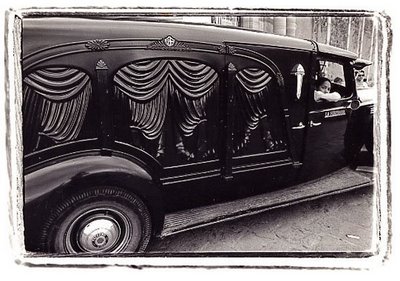
If even dying is to be made a social function, then, please, grant me the favour of sneaking out on tiptoe without disturbing the party.
Markings, Dag Hammarskjöld
Georgia Straight technology columnist, Dave Watson died of colon cancer on May 7th. Former Georgia Straight editor Charles Campbell wrote a fine obituary here. He was 45 and what separated his death from most of our own inevitable deaths is that he knew he was going to die with far more precision than any of us. Perhaps he was lucky to know or not. We look at his death, and like many a greenhorn soldier on the eve of battle, I wonder how I will face death. Will I be a coward? Will I be unflinching?
Campbell's obituary is followed by glowing remembrances from friends and colleagues. I never considered contributing. I have a very good reason.
When I first met Watson in the early 80s I worked at Vancouver Magazine. I had the lucky gig of contributing photographs to Les Wiseman's rock column In One Ear. The column was hip as it avoided mainstream music and concentrated on the lesser known proto punk (New York Dolls) the critically acclaimed Iggy Pop (then not popular with the crowds) and with the odd but wonderful local Vancouver alternative music scene. I had no knowledge of who Hunter S. Thompson was and did not understand when Wiseman would introduce me as, "This is Lenso, my Argentine lensman." I did not have the foggiest when he often started conversations with me , "As your attorney I would....." Or he would say stuff like, "When in doubt, drink heavily." I remember being back stage at the Commodore getting ready to photograph the Cramps. I wrote about it here. I had to make sure Wiseman had plugged in his tape recorder. He was in no shape to notice.
Around this time Watson started showing up at Vancouver Magazine. He worshipped Wiseman and admired Wiseman's methods for inspiration and how he wrote about rock and roll. He loved the off-beat articles that Wiseman wrote such as one on learning to drive a semi trailer.
Watson was a good looking young man, even with his glasses, he was not tall and he had a monotone voice, matter-a-fact kind of voice. He had clear and sharp eyes and no matter how much he told me had drunk or pills he had popped he always looked, acted and was extremely sober.
For years my friends had told me I needed to loosen up. They tried to get me drunk but after only a couple of beer I would be hit by terrible migraines. In Mexico they tested peyote on me. I threw it up and that was it. Maurice Depas (of Maurice & the Cliches) made me puff incredibly strong hashish. The only result was extreme stuttering. I learned to understand that for me there was no escape from problems, the chemical forgetting of them was not an option. I came to suspect that the one thing I could be sure of was that I was going to die sane.
I looked at Watson as my fetch. Like me he was as straight as they came. In many conversations with Watson through the years, particularly about computers, he never made me change my mind that he was a straight as an arrow.
It is my hope that somehow my exit will be as good as his but I have no illusion or wish that anybody write a fine obituary. Obituaries are for the living. The dead get no profit. We the living can only ponder every day if we will face our death with our chin up.
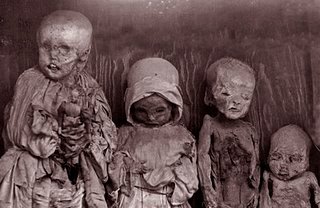
I took the photograph of the Packard hearse outside of the Guanajuato, Mexico cemetery back in 1968. The gate of the cemetery is decorated with skulls and children outside sell sticky taffy shaped like the mummies that people go inside to look at. After 7 years bodies are disinterred (if no perpetuity charges have been met) and the bones at thrown away. There is very little room in the cemetery for expansion. But often because of the arid weather and the chemicals in the soil the bodies are found mummified. A gallery is kept which shocks tourists but Mexicans take in their stride.
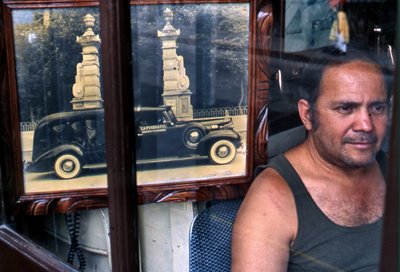
Three years ago Rebecca, Rosemary and I went to Guanajuato. On one of the streets I spied the picture of the hearse on the wall of a funeral service. I entered and asked the man. When I described my photo he told me it was his sister when she was young. The Packard had been purchased by a car museum in Cincinnati.

I have, easily 400 hostas in our garden. I have green ones, yellow ones (sometimes called gold), blue ones and variegated ones. Some of the variegated have yellow edges or white edges and are variegated or streaky on the inside. The streaks can be yellow, green or blue or a combination of all three. Some have asymetrical variegation. I even have some really ugly ones like Mildred Seaver's Hosta 'Spilt Milk'. I will never admit to saying this out loud but I tolerate Spilt Milk because Mildred Seaver is dear to me. On any given summer day I will answer the question, "Which is your favourite hosta?" by picking the colour of the day. Of late and only a week ago when Rebecca asked me I told her it was Hosta 'June'. Hosta 'June' is a truly English hosta as it was hybridized (not quite as it was found as a sport or mutant in a bed of Hosta 'Halcyon') in England. It flowers like crazy, it has thick substanced leaves that are imperviuous to munching slugs. It is its variegation that is elegant and striking. All that see it want it. All that see mine specially want it. Many of the Hosta 'June' sold in Vancouver come from American nurseries and they have lost the original understated variegation of the English one. My English June was liberated from England, it traveled to the US and it was given to me for services rendered. It came home in my luggage.
The particular elegance of June has to do with the shape of its leaves. Hosta leaves can be thin and lanceolate or they can be almost round. Some of them can be puckered or dimpled. Some are smooth and some are smooth and shiny. June's leaves are spade shaped and they have an elegant slight curvature in the middle. Some hostas can be so curved as to resemble gourds. In short, Hosta 'June' has everything. That is until I thought about it today.
In the late 60s while working at the famous English nursery of Hilliers of Winchester, architect trained, Southampton born , Eric Smith became its chief propagator. He worked in the walled garden for four years. He came up with new hellebores, bergenias, brunneras, camassia crocosmia, kniphofi and rheums but one cross made him famous. Most hostas flower in June. One in particular Hosta sieboldiana and Hosta sieboldiana 'Elegans' are big and blue with thick leaves. Hosta 'Tardiflora' flowers in Septmeber and has narrow, shiny green leaves. Somehow one of his sieboldianas re-flowered in September do Smith used its pollen to fertilize the Tardiflora's pod. From this cross arose a whole series of mostly blue hostas called called Tardiana (Tardiflora/sieboldiana combined) grex.
Most of these blue hostas inherited the blueness of Hosta sieboldiana with the narrowness of Tardiflora's leaves. Most of the Tardianas have either white flowers like sieboldiana or purple/mauve like Tardiflora.
One of the bluest in my garden is Hosta 'Halcyon'. Another Smith hosta, Hosta 'Camelot' is slightly bluer in my garden but its leaves are just a bit rounder to lose the elegance of Halcyon.
No matter where I place Halcyon, it will be noticed and immediately identified while I may waffle at the names of others and their confusing variegation.

Today while working in the garden and noticing many of my Halcyons I realized that many of my other hostas are flings, exotic flings. Many because of their variegation are hard to keep in good shape. They have less chlorophyll and can be sensitive to too much light or have thinner leaves and are subject to slugs and cut worms.
Not Halcyon. She (she is definitely a she) is tried, true, faithful, stays were it is placed and when placed next to a yellow plant it makes the yellow yellower while appearing itself much bluer. She has only one request and that is that nobody should touch her delicate white/blue coating called bloom. It is sensitive to touch and where you touch it will become green and the blueness will not return until the next season. Not in the least worse for wear, she will be back, unfailingly.
In the picture above, Halcyon is seen in the middle top. To the right is the larger leaved Hosta 'Sieboldiana Elegans'.

If even dying is to be made a social function, then, please, grant me the favour of sneaking out on tiptoe without disturbing the party.
Markings, Dag Hammarskjöld
Georgia Straight technology columnist, Dave Watson died of colon cancer on May 7th. Former Georgia Straight editor Charles Campbell wrote a fine obituary here. He was 45 and what separated his death from most of our own inevitable deaths is that he knew he was going to die with far more precision than any of us. Perhaps he was lucky to know or not. We look at his death, and like many a greenhorn soldier on the eve of battle, I wonder how I will face death. Will I be a coward? Will I be unflinching?
Campbell's obituary is followed by glowing remembrances from friends and colleagues. I never considered contributing. I have a very good reason.
When I first met Watson in the early 80s I worked at Vancouver Magazine. I had the lucky gig of contributing photographs to Les Wiseman's rock column In One Ear. The column was hip as it avoided mainstream music and concentrated on the lesser known proto punk (New York Dolls) the critically acclaimed Iggy Pop (then not popular with the crowds) and with the odd but wonderful local Vancouver alternative music scene. I had no knowledge of who Hunter S. Thompson was and did not understand when Wiseman would introduce me as, "This is Lenso, my Argentine lensman." I did not have the foggiest when he often started conversations with me , "As your attorney I would....." Or he would say stuff like, "When in doubt, drink heavily." I remember being back stage at the Commodore getting ready to photograph the Cramps. I wrote about it here. I had to make sure Wiseman had plugged in his tape recorder. He was in no shape to notice.
Around this time Watson started showing up at Vancouver Magazine. He worshipped Wiseman and admired Wiseman's methods for inspiration and how he wrote about rock and roll. He loved the off-beat articles that Wiseman wrote such as one on learning to drive a semi trailer.
Watson was a good looking young man, even with his glasses, he was not tall and he had a monotone voice, matter-a-fact kind of voice. He had clear and sharp eyes and no matter how much he told me had drunk or pills he had popped he always looked, acted and was extremely sober.
For years my friends had told me I needed to loosen up. They tried to get me drunk but after only a couple of beer I would be hit by terrible migraines. In Mexico they tested peyote on me. I threw it up and that was it. Maurice Depas (of Maurice & the Cliches) made me puff incredibly strong hashish. The only result was extreme stuttering. I learned to understand that for me there was no escape from problems, the chemical forgetting of them was not an option. I came to suspect that the one thing I could be sure of was that I was going to die sane.
I looked at Watson as my fetch. Like me he was as straight as they came. In many conversations with Watson through the years, particularly about computers, he never made me change my mind that he was a straight as an arrow.
It is my hope that somehow my exit will be as good as his but I have no illusion or wish that anybody write a fine obituary. Obituaries are for the living. The dead get no profit. We the living can only ponder every day if we will face our death with our chin up.

I took the photograph of the Packard hearse outside of the Guanajuato, Mexico cemetery back in 1968. The gate of the cemetery is decorated with skulls and children outside sell sticky taffy shaped like the mummies that people go inside to look at. After 7 years bodies are disinterred (if no perpetuity charges have been met) and the bones at thrown away. There is very little room in the cemetery for expansion. But often because of the arid weather and the chemicals in the soil the bodies are found mummified. A gallery is kept which shocks tourists but Mexicans take in their stride.

Three years ago Rebecca, Rosemary and I went to Guanajuato. On one of the streets I spied the picture of the hearse on the wall of a funeral service. I entered and asked the man. When I described my photo he told me it was his sister when she was young. The Packard had been purchased by a car museum in Cincinnati.
Sunday, May 18, 2008

Before the performance of Pi Theatre's production of William Maranda's The 8th Land, directed by John Wright I knew I had to write a blog in thanks for the years of pleasure I have received from the Wright family via John Wright's daughter Johnna Wright and husband Del Surjic. The new artistic director for Pi, Richard Wolfe (in company of general manager Emma Luna Davis) announced that Surjic, his predecessor at Pi, was leaving for Saskatoon where he will be the artistic director of Persephone Theatre. With Surjic leaving we will also miss Johnna Wright.
I didn't sleep much last night. I knew I had a picture of Surjic (in photo above left) I took on February 2003 for the Georgia Straight. It was a preview of Pi Theatre's Elisa's Skin. Here you see Surjik (right, with Marie Stillin and Jean-Michael Legal. I didn't sleep last night because I couldn't find the pictures with Johnna Wright. I knew I had photographed her for the Straight in relation to the founding of See Seven. I looked under See Seven, See 7, C Seven, C 7 and found nothing. I didn't sleep. I had nightmares involving last night's scary performance by Linda Quibell who on stilts (playing goddess Hiva)and with a striking costume by Marti Wright was the ethnic mother-in-law from hell! Photo (I took this some years ago for Felix Culpa) bottom left.
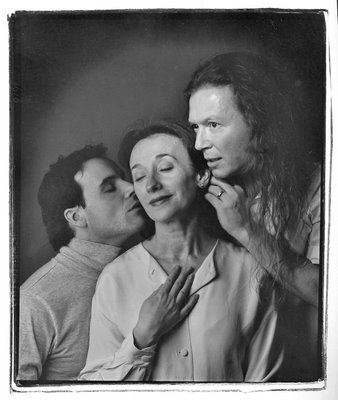
This morning I remembered and I ran down to my files and looked under Bloom, David (the Director of Felix Culpa). And there was the picture of Johnna Wright, Del Surjic, David Bloom (top left) and Ruby Slippers' director Diane Brown. Photo is top left.
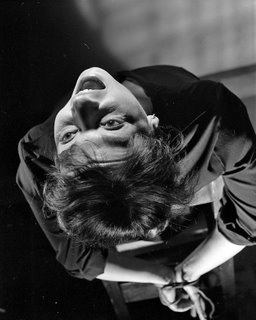
This story really begins during the 2002 Christmas season when Rosemary and I went to see the Solo Collective's three one act, one actor plays A Christmas 3. The three plays Kiljoy with Lois Anderson, Office Party with Bill Dow and Wobbling Maddona with Sheelah Megill (in picture Megill is far right) was a virtuoso performance night. Rosemary, who likes little, liked a lot. In particular we loved Johnna Wright's direction of Killjoy and Del Sujik's direction of Office Party.
Rosemary asked me who the director for Killjoy was. Lois Anderson was fantastic. I pointed at a woman who was sweeping the floor between plays and said, "The floor sweeper, that's Johnna Wright." Rosemary was then not surprised to see Wright selling sweets and drinks during the intermission.
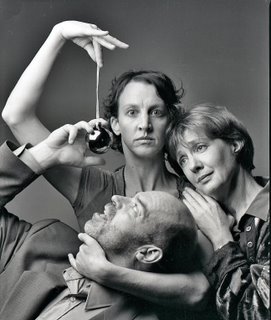
This is theatre in Vancouver. It is a pity that perhaps nobody will acknowledge or appreciate the contribution of this couple until they are gone. My guess is that with Richard Wolfe as the new artistic director of Pi Theatre we will be subjected to more cutting edge theatre if his directorship of Theatre Conspiracy is an example.
In the beginning I was troubled by last night's performance of The 8th Land. It had a lot of hocus pocus. It was contrasted by the interesting music of Oriental (La República Oriental del Uruguay) Pepe Danza and the intriguing contribution of four singing, chanting, martial arts fighting, insects (flees and flies) played by Sarah Afful, Spencer Atkinson, Nick Fontaine and Thrasso Petras. The sets by David Roberts were interesting, elaborate and finely crafted.
But then I warmed up to all the hocus pocus. I was watching a modern version of a Greek play. The voices of all the actor were (unlike the voices of modern radio) superb. I recognized the man playing the lead part of Te-Te, Parnelli Parnes but I could not place him until I read he had been in the Banana Boys.
The evening was specially enjoyable because of the tropical heat of an unseasonably hot evening. I looked at all the usual suspects, including Felix Culpa's David Bloom and I felt sad that Surjik and Wright will not be with us. But I am grateful that all these usual suspects have challenged my perception of what theatre is supposed to be. They have done this gently and entertained me to no end.
Thank you.
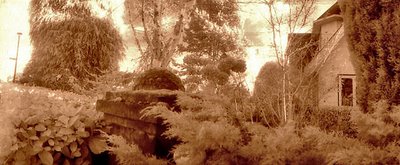
I wrote about my laurel hedge before here. I have to finish with it today, for yet another year. I have pruned the sides and I have left the top for today. It promises to be sunny and hot and I cannot wait for Rebecca and Lauren to show up by noon. I hope to be finished with the hedge by then so that we can spend time exploring in the garden. We will see which roses are about to bud out and look at some of our recent acquisitions. I have eschewed all those variegated hostas of yore and I purchased yesterday an all green one (with tall and stately leaves and white flowers) called Hosta 'White Triumphator'. One of our new small shrubs is the oddly named Sorbaria sorbifolia because its foliage is similar to a sorbus tree.

The heat will remind me of last year's horse and carriage tour with Rebecca and Rosemary in Mérida, Yucatán. As we clopped on a hot Sunday summer evening we passed boulevards of oleanders. They precipitated a nostalgia for my Buenos Aires garden where we had several. My mother had warned me often about its poisonous nature. But the smell of the oleander is ingrained in the skull of my memory. I smile when Rebecca asks me, "Papi what plants are poisonous in your garden?" She then asks me to show her the location of all our aconitums. They happen to be favourites of Rosemary who has a fondness for any plant with blue flowers.

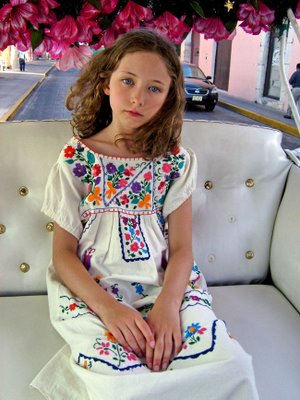
Who know how many more iced tea, (almost) summer Saturdays we will have with the two girls. But I will try to enjoy today in what promises to be a glorious day in the garden.
One day, quite some time ago, I happened on a photograph of Napoleon's younger brother, Jerome, taken in 1852. And I realized then, with an amazement I have not been able to lessen since: "I am looking at eyes that looked at the Emperor." Sometimes I would mention this amazement, but since no one seemed to share it, nor even understand it (life consists of these little touches of solitude), I forgot about it.
Chapter 1 - Camera Lucida - Reflections on Photography
Roland Barthes
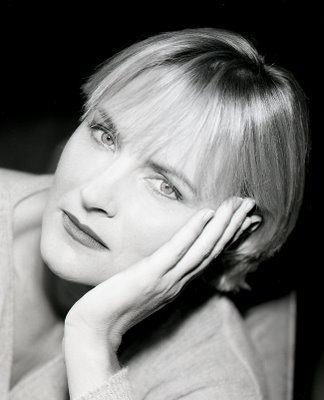
I don't quite remember the circumstances or reasons as to why I faced actress Denise Crosby at the Meridian Hotel in November 1994. I had always been a fan of the original Star Treck with William Shatner and Leonard Nemoy. In fact my first introduction and subsequent addiction to Star Treck was its Mexican version which I saw in Mexico City in the early 70s dubbed into Spanish. Sample, "¡Chihuahua! ¿Donde está el señor Espok?"
The fact that Denise Crosby was the Security Chief Tasha Yar on the first season of Star Trek: The Next Generation did not impress me in the least. I have always hated this pretentious version of what until then was a fun series that did not take itself too seriously. I don't think William Shatner would have ever seriously considered playing a serious Hamlet.
But once I was in the presence of someone who had known Bing Crosby (I felt that same tingle the couple of times I photographed Bob Hope) everything changed. I cringe at my photographs and I cannot understand why I ignored her generous cleavage! But in her presence I felt as if somehow I was George Hurrell taking pictures of Norma Shearer. Crosby had this star presence, this old Hollywood presence.
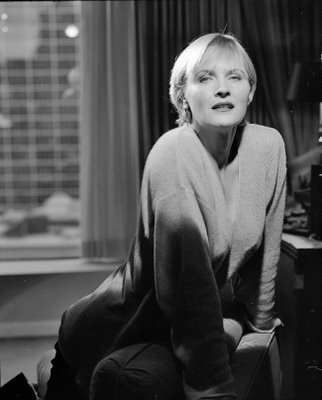
Crosby giggled when she heard my impersonation of "Capitán Keerk".
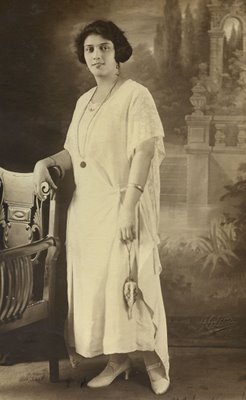
It was only in the last years of her life when my grandmother Lolita was in her 70s that she was no longer able to sing. She had forgotten who she was. I remember that she came back from Egypt where she had visited her son (my uncle) Tony. When she deplaned she looked at me and I saw nobody there. Before that whenever anybody in our family or a friend got married Lolita was asked to sing at the wedding. Her signature song was Francisco Santiago's Ave María. It is only in the research of this blog that I have found out that Santiago was born in Santa María, Bulacan in the Philippines in 1919. I had thought Santiago a Spaniard. Well into her late 60s my grandmother's soprano (with coloratura she always told us) was clear and beautiful.
She had wanted to be an opera singer. Her father (who had been a baker in Spain) said that people of social standing were never opera singers. But Lolita's sister Buenaventura was allowed to continue in her career as a concert pianist of note in the Philippines. I often wonder what would have happened if my grandmother had followed her star. Seen here is a picture of her in the early 20s when she (a recent widow) and her three children arrived in New York. By the end of the 20s Lolita was working for Winthrop, a pharmaceutical company. Her singing star had dimmed.
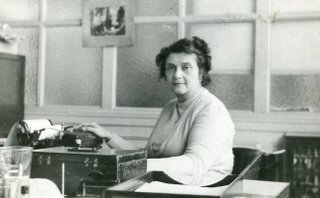
From Lolita I learned quite a bit about opera. I might have learned more if I had really been interested. But my ears would open when she told me of performances of Aida at the Met in New York that had live elephants and camels. She told me of going to a theatrical presentation of Ben Hur that had a fight involving galleys at sea (on stage!). Lolita would sing arias for me and some of her favourites were from Aida.
It has been a strange two months going with Rebecca to Opera Sushi after her Wednesday ballet class. The selection of operas on DVD at the restaurant are limited so we have been watching Aida in different stages but somehow (while we saw the beginning and the end) we had never seen the triumphant march until yesterday evening. In this 1989 Met version with Plácido Domingo as Radames, Sherrill Milnes as Amonastro, April Millo as Aida and Dolora Zajick as Amneris there are no elephants or camels. But Rebecca did brighten up when the beautiful white horses (with plumes) pranced across the stage.
I was struck by melancholy and I watched Rebecca's sad eyes. Her father had forgotten and not taken her last Friday to her ballet's school recital. All her dance mates had been given gold medals. She did not get a medal and her ballet teacher was furious. I grieved at a 10 year-old having to be unhappy. I imagined my grandmother singing the arias from Aida and Rebecca listening rapt at Lolita's performance. I wonder what it is that Rebecca will do some day. Will she be a dancer? A pianist? Or will she end up at a boring job and the very spirit that now shines through her eyes will be muted? At 10 I had no idea of these things. In this 21st century does one have to worry and make decisions much earlier?

I take heart in the knowledge that one of my favourite Vancouver modern dancers, Katy Harris-McLeod, right, did many things in her early life including tree planting and only decided to be a dancer when she was 27. I really did not become a photographer until I came to Vancouver in 1975. I was 33.

IN 1988, two years into our new house with garden, I remember Hilary was studying on the lawn. I was excited as I was taking pictures with my large RB-67 mounted on a tripod. There was a view under the hawthorn tree with tulips and a hosta that was specially handsome. I asked Hilary to take a look through the viewfinder. Her answer was terse, "I am not interested in your garden." And that was that. Perhaps I am trying to get even by giving Rebecca (and recently, Lauren) potted roses, hostas and a rare Rhododendron 'Golfer'. Rebecca tends to her back patio garden and in the spring I show up with bigger pots to transplant the roses. We prune them together. I bring good dirt and some manure. To induce (so they say) new basal shoots on the roses I bring a mixture of magnesium sulphate (epson salts) and alfalfa meal.
My guess is that Rebecca's neighbourhood friends must think her strange to have her own garden. The irony here is that my mother gardened and I played a lot in our Buenos Aires garden. I climbed the many plum trees to feast on the fruits but avoided eating from my father's kaki (persimmon) tree. But I had strung a rope from the tree to a wraught iron fence and I zoomed down using a y-shaped branch. While I was too young to be really interested in the garden my mother's plants registered in my memory so we have iris and calla lillies in our Athlone garden to remember my Buenos Aires garden. There are other plants but they will not grow in our climate.
So now as Rosemary and I prepare the garden for the Ballet BC House and Garden Tour for the other weekend I think of my mother and how she would love to discover our plants and what she would feel on seeing Rebecca and Lauren play in it. Their mother, Hilary is interested in medicinal herbs but the garden still does not seem to faze her. I might have to wait for her to buy her first house and hope that it has a garden so that I can feel that somehow this family garden interest is being transfered.
I also think of my friend W. George Schmid. I wrote about him here. Rosemary is stressed and worried. We brag that our garden is a "shoulder to shoulder" garden. George came up with the term that defines a garden with beds that show no dirt as plants lean on each other and weeds are supressed. Will it be, indeed, a shoulder to shoulded garden by May 24th and 25th when we open the garden? We hope that yesterday and today's rain coupled with the coming sun will make our plants stretch out.
Preparing a garden for an opening is much like getting a no-haircut haircut. You want to make the garden look manicured but not manicured recently. Will I mow next Thursday? Time will tell.

Since 1986 I have purchased many dwarf conifers and conifers for the garden. At first my inexperience meant that I had several coniferal deaths. Many of the formerly called chamaecyparis (false cypresses) which have been recently promoted to cupressus (the cypress family)and many pinus (pines) did not like the winter wet and relatively poor drainage of my garden. But many survived and even thrived.
Some years ago I purchased three Abies koreana 'Nana' or dwarf Korean firs at a UBC plant sale. The moniker nana was incorrect as the three grew quite tall and the tallest is now 9 ft high.
Korean Fir, (Abies koreana; 구상나무, Gusang namu in Korean) is a fir native to the higher mountains of South Korea, including Jeju-do island.
What is startling about this conifer is that the underside of the leaves (conifers have leaves even if those needles don't look like them) are silvery white so that in a wind the whole tree shimmers. Startling, too are the upright cones which in spring can be blue, purple of light green.
When I married Rosemary some 40 years ago she used to smile when we purchased a Canadian Christmas tree every year. In Spanish all conifers are pinos or pines. The more discerning might know the existence of abetos (abies or firs) or the existence of the extremely Mexico City pollution tolerant juníperos or junipers. Thujas (Western Red Cedars) true cedars and other exotic conifers are all but unknown. All conifers are pinos!
In our travels through Mexico in our VW beetle we saw many pines. In the mountains of Oaxaca, in Xalapa, Veracruz and elswhere. It was only here in Vancouver just a few years ago that I learned that Mexico is home to the greatest variety of pine species in the world.
It was also in Vancouver that I found out that the Western Red Cedar is not a cedar but a Thuja and that the one in my garden is a Thuja plicata and is not related to cedars but to the pine family. Furthermore I found out that the Douglas Fir is not a fir or (in the proper botanical name an abies) but a pseudo hemlock. Because a Douglas Fir looks somewhat like a hemlock (Tsuga) it is botanically called a Pseudostuga and are all part of the pine family. The useless fact to remember is that a cedar fence is really not a cedar fence (Western Red Cedar or Thuja plicata) and that a true cedar or cedrus is a conifer family from Europe. I have several true cedars in my garden and most are weeping cedars or Cedrus deodara .
Also salient, in my opinion, is the knowledge that one should never have a roof with cedar shingles. Years ago when I visited veteran broadcaster Jack Webster in his Saltspring Island retreat he started our barbecue dinner fire with cedar shingles.

As a parting shot I would like to rectify the idea that all conifers are evergreen. There are several that are not. I wrote about one of them here. You can see a branch of Larix kaempferi and its cones here alongside the Abies koreana's cone and a branch showing the silver underside.
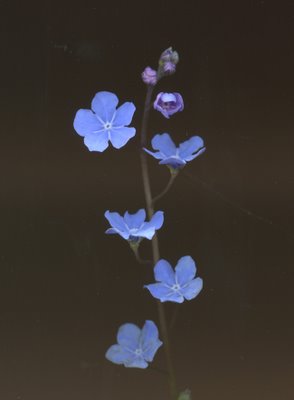
While I have always enjoyed the comfort of spooning I didn't know what it was called until recently. Yesterday Rosemary and I had an intense day in the garden getting it ready for the Ballet BC Home & Garden Tour 2008.
We each work in our areas but we meet to move a plant. She will hold it up so I can see where the roots are and I go at it with a spade. I dig a hole and while Rosemary places the plant in its new spot I fill a bucket with our pond's water to puddle in the plant to reduce the moving shock.
It is about now when my friend Donald Hodgson and I would talk hosta on the phone. Hodgson died a few months ago. He had a home wholesale hosta nursery in North Vancouver. He selected tried and true hostas like Hosta montana 'Aureomarginata', Hosta 'Halcyon', Hosta 'Gold Standard' and such stalwart and beautiful species hosta like Hosta nigrescens. He lovingly grew them in large pots and then sold them to the best nurseries in town. Whenever I had a garden tour I would go to his house and he made the exception of selling to me retail so I could "bulk" up some of my hostas that were not doing too well or to fill empty areas of the garden.
We talked hosta and we talked on how lovely the garden got to be now when you could discern change and growth from one day to the next. The hosta leaves as the plants unfurled are a tender green and pristine with no slug holes. The first thing Rosemary and I do in the morning is to run to the bathroom window and look out into the back garden.
Last night we were exhausted and getting into bed and out of bed (perhaps to get a mug of tea) brought groans as our pained limbs protested movement. No amount of hand cream lessened the roughness of our hands.

But as I gazed upon this tiny flower, Omphalodes cappadocica a plant I would not have noticed anywhere I realize that Rosemary and I spoon in our garden. We fit into each other's tastes and somehow the end result, our garden, is definitely ours.

A seemingly unlikely confluence of events led to today's scanning of a small bit of lettuce. The bit of lettuce is what was left from Rosemary's lettuce, carrot, tomato and celery salad from last night's mother's day dinner. Perhaps it was precipitated when I opened the refrigerator this morning and the remnants of the salad, in a bowl we purchased in Málaga many years, ago fell out and broke.
It all began a couple of weeks ago when Rosemary and I watched in the Turner Classic Movies channel, Sam Peckinpah's 1965 Western Major Dundee with Charlton Heston, Richard Harris, Santa Berger, James Coburn, Slim Pickens and Jim Hutton. Ben Johnson and Warren Oates, two future staples of Peckinpah movies played understated (most uncharacteristic) roles.
And there was also Mexican actress Begoña Palacios.
One of the most often repeated and comforting scene of Peckinpah's Mexican Westerns (The Wild Bunch is certainly another) is a group of rough and tough gringos entering a Mexican village. They soon befriend the villagers and there is a party. There is a cheerful farewell in the end. Nasty Mexican Federales or in this case French imperial forces take revenge on the poor villagers for helping the gringos.
As I watched this fully restored (all the cuts were reinstated in a movie that caused so much uproar because of the director's overbudget and alcoholism) I thought of the fact that Heston went without pay to convince the producers to keep backing the production of the film. But I became melancholic and nostalgic when I noticed Mexican actress Begoña Palacios who convincingly (most demurely) competed with the much more voluptuous Santa Berger who proudly showed her cleavage while strategically pushing her Mexican rebozo to one side.
Begoña Palacios married Sam Peckinpah an extraordinary three times. Here is a short biography:
Begonia Palacios, in spite of being a well-known actress in her native Mexico, was better known as the three-time wife of director Sam Peckinpah. The actress and the director first met when Peckinpah cast her in his 1965 film, Major Dundee. The duo shared an extremely volatile relationship, as evidenced by their unusual three marriages. Palacios and Peckinpah remained close, despite their differences, until his death in 1984 -- he was reportedly journeying to see her when he was stricken, on her birthday no less, with his fatal heart attack. Palacios died in early 2000 and her ashes were scattered off the shores of Malibu, CA, the same location where Peckinpah's ashes were strewn. ~ Ryan Shriver, All Movie Guide
The next event that has led to the bit of lettuce happened yesterday in the afternoon when Rebecca asked me to play any music of my choice. I chose Aaron Copland's Lincoln Portrait directed by Maurice Abravanel and the Utah Symphony Orchestra. The piece was narrated by Charlton Heston. Rebecca had never heard of Heston, Ben Hur, A Touch of Evil and, much less, Major Dundee. We will have to see Ben Hur together. But Rebecca did comment that Heston's voice was most interesting.
For mother's day dinner the chicken I was making in the outdoor barbecue had to be finished in the oven when the gas was exhausted. I placed the chicken with the basting liquid in a pyrex dish and the result was a resounding and juicy success. After a dessert of apple flambé (with Pernod, butter and cream) we watched Rossini's Ghost from the series called The Composers' Specials . When Hilary was about to leave she said, "This has been an unusual mother's day."
I thought about it overnight.
Begoña Palacios would have been called "a lechugita" (a small head of lettuce) by Mexicans to describe her vuluptuous and lively nature. But better still she would be called "a mamacita" (little mother). Mexicans have a complex relationship with motherhood, and with diverse meanings of the word. This complex relationship was best explained by Mexican writer/poet/diplomant Octavio Paz in his book (1950) El Laberinto de la Soledad (The Labyrinth of Solitude).
It all began when Doña Marina (as Spaniards affectionately call her) or La Malinche, the disdainful Mexican epithet "sold out" her country by translating for Hernan Cortez and then complicating it even more by bedding the conquistador and having a son. To this day a "malinchista" is a Mexican who prefers foreign goods.
Mexicans have some strange expressions related to mothers and motherhood. "My mamacita" can be an endearing term describing one's dear mother or in most cases one's dear mistress. A mamacita is a lechugita , a beautiful young or not so young woman. When Rosemary would walk home from teaching English to our apartment in Mexico City's Zona Rosa, bricklayers and construction workers would shout "¡Mamacita!" at her. I don't blame them. Rosemary had beautiful legs and wore extra short mini skirts. That she was close to 8 months pregnant at the time had no bearing.
A papacito (or little father) has nothing to do with fatherhood and all to do with a man who is cool and can pick up women. A papacito has many mamacitas.
The most complex term involving the word mother in Mexico is madre or mother. "Te voy a dar en la madre." which losely translates to "I will give it to you in your mother, " means, "I am going to fu-- you over, and get even with you." Octavio Paz mentions the curious fact that this fictitious place, this abstract place (the mother in you that I am going to get at) is nowhere and cannot be found anywhere. Mexican's will commonly utter, "Me dieron en la madre,", when they suffer a financial problem, had an automobile accident or failed a test in school.
Yet "a toda madre" (sort of all mother) is used to denote something fantastic. ¡Vancouver "es a toda madre! would mean that Vancouver is a happening place. But "no vale madre" (it's not worth a mother) means that something is worthless and shoddy. To confuse it further, "Vancouver es un lugar padre," (Vancouver is a father place) means the same thing as !Vancouver es a toda madre!
Such is the alternate almost obscene meaning of madre and mamacita that Mexicans reserve another variant "madrecita" (little mother) which has not sexual meaning and is pure long and sufferning and kind mother.
Such is the Mexican obsession with motherhood that the ultimate insult is to state that your oponent should have sex with his mother. The perennial American (Frank Sinatra used it a lot) finish to a song "ta, ta, ta-ta-ta - tá-tá" means just that. For many years Mexicans would honk their car horns to insult those with lesser motoring skills. Expensive fines were instituted by the authorities to counter this vehicular obscenity. So ever-so-quick Mexicans simply honk their horn twice, tá, tá. Everybody knows this is not an endearing motherly term.
And yes, Begoña Palacios in Major Dundee, is a lechugita, a mamacita. Her performance is "a toda madre" and Charlton Heston "les dió en la madre a los Franceses" soundly defeated the Frenchies. In fact since mother's day in Mexico is always celebrated on May 10th and the Mexican defeat of the imperial French forces in Puebla happened on May 5th, the Puebla holiday is sometimes called "La Media Madre" or "half mother".
¡Begoña Palacios, mamacita, mamacita!
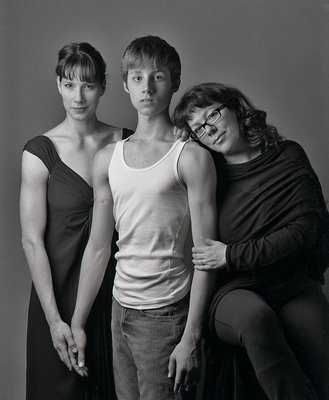
Lauren, Rebecca (both dressed to the teeth) and I attended the Arts Umbrella Dance Company Season Finale last night at the Vancouver Playhouse. I have gone to these before with Rebecca and it features the Senior Company Dancers and the Apprentice Company Dancers. As a special treat that happened because of an exchange program the evening also featured Joffrey Ballet School Dancers (no less!) and a finale, Samsara (choreographer Margo Sappington) that combined both dance companies and brought down the house with intensity, music and costumes to die for.
Rebecca and I go to a lot of dance and Lauren is becoming an aficionado, too. We know what we like. I find it curious that even if you compare this yearly Arts Umbrella tradition to any other dance performance by any company, be it Canadian or international, only the Arts Umbrella performance seems to be, essentially, intense and pure dance. Only La La La Human Steps from Quebec leaves me as exhausted and satiated.
Last night was no exception. At a pre-performance reception were Rebecca chatted with Emily Molnar and Tiko Kerr, we were asked when we felt most alive. The question was immediately answered that dancers, the Arts Umbrella dancers, feel most alive when they dance. That made me think as I am too self-concious when I dance the Argentine tango to feel alive. I am much too worried if I am doing the right steps.
I would say that I feel most alive during a portrait session. There is that instance when I know I have my shot. And I know I can quit at that moment and not fret anymore. Attempting to take that photograph with fewer and fewer exposures (in an age of digital regurgitation) is specially satisfying.
In a number before the intermission, Grosse Fugue (by dazzling Toronto choreographer Roberto Campanella) in a beginning with absolute silence (Beethoven was to be later) Alex Burton and Alyson Fretz danced together. Burton's profile would have launched a thousand ships of Amazon women. Burton and Fretz, for a few moments, were the ultimate Romeo and Juliet falling in love. The sexuality, intense as it felt to me, was romantic, classy, tender. I felt like running up to Ballet BC's John Alleyne (sitting in the back row) and saying, "Mr Alleyne, choreograph your version of Romeo and Juliet. You have your dancers here, and now."
I was alive.
There were some moments of retrospection for me. I wonder why Rebecca and her powers that be do not understand that women like dancer and choreographer Emily Molnar, and dance director Artemis Gordon (seen here with Alex Burton) instill in dancers a way of life that will make them better persons even if they ultimately do not become dancers. They learn unflinching commitment and a desire to do their best in a world that is bocoming more and more a world of mediocrity and incompetence.
Rebecca and I missed Nina Davies our most favourite and flexible dancer. She has back problems (at this moment unresolved). I have watched Davies dance for some four years and I have chatted with her and her mother Kitty. At age 16 she is the very model of the girl I would like Rebecca in some way to resemble. But let me end with a humorous note. Artist Tiko Kerr introduced a gentleman to her. "Rebecca, this is my husband Craig." A few moments later, a puzzled Rebecca asked me, "How can that be?" And then she immediately said, "Oh, yes I understand now."
I was alive.

Before the performance of Pi Theatre's production of William Maranda's The 8th Land, directed by John Wright I knew I had to write a blog in thanks for the years of pleasure I have received from the Wright family via John Wright's daughter Johnna Wright and husband Del Surjic. The new artistic director for Pi, Richard Wolfe (in company of general manager Emma Luna Davis) announced that Surjic, his predecessor at Pi, was leaving for Saskatoon where he will be the artistic director of Persephone Theatre. With Surjic leaving we will also miss Johnna Wright.
I didn't sleep much last night. I knew I had a picture of Surjic (in photo above left) I took on February 2003 for the Georgia Straight. It was a preview of Pi Theatre's Elisa's Skin. Here you see Surjik (right, with Marie Stillin and Jean-Michael Legal. I didn't sleep last night because I couldn't find the pictures with Johnna Wright. I knew I had photographed her for the Straight in relation to the founding of See Seven. I looked under See Seven, See 7, C Seven, C 7 and found nothing. I didn't sleep. I had nightmares involving last night's scary performance by Linda Quibell who on stilts (playing goddess Hiva)and with a striking costume by Marti Wright was the ethnic mother-in-law from hell! Photo (I took this some years ago for Felix Culpa) bottom left.

This morning I remembered and I ran down to my files and looked under Bloom, David (the Director of Felix Culpa). And there was the picture of Johnna Wright, Del Surjic, David Bloom (top left) and Ruby Slippers' director Diane Brown. Photo is top left.

This story really begins during the 2002 Christmas season when Rosemary and I went to see the Solo Collective's three one act, one actor plays A Christmas 3. The three plays Kiljoy with Lois Anderson, Office Party with Bill Dow and Wobbling Maddona with Sheelah Megill (in picture Megill is far right) was a virtuoso performance night. Rosemary, who likes little, liked a lot. In particular we loved Johnna Wright's direction of Killjoy and Del Sujik's direction of Office Party.
Rosemary asked me who the director for Killjoy was. Lois Anderson was fantastic. I pointed at a woman who was sweeping the floor between plays and said, "The floor sweeper, that's Johnna Wright." Rosemary was then not surprised to see Wright selling sweets and drinks during the intermission.

This is theatre in Vancouver. It is a pity that perhaps nobody will acknowledge or appreciate the contribution of this couple until they are gone. My guess is that with Richard Wolfe as the new artistic director of Pi Theatre we will be subjected to more cutting edge theatre if his directorship of Theatre Conspiracy is an example.
In the beginning I was troubled by last night's performance of The 8th Land. It had a lot of hocus pocus. It was contrasted by the interesting music of Oriental (La República Oriental del Uruguay) Pepe Danza and the intriguing contribution of four singing, chanting, martial arts fighting, insects (flees and flies) played by Sarah Afful, Spencer Atkinson, Nick Fontaine and Thrasso Petras. The sets by David Roberts were interesting, elaborate and finely crafted.
But then I warmed up to all the hocus pocus. I was watching a modern version of a Greek play. The voices of all the actor were (unlike the voices of modern radio) superb. I recognized the man playing the lead part of Te-Te, Parnelli Parnes but I could not place him until I read he had been in the Banana Boys.
The evening was specially enjoyable because of the tropical heat of an unseasonably hot evening. I looked at all the usual suspects, including Felix Culpa's David Bloom and I felt sad that Surjik and Wright will not be with us. But I am grateful that all these usual suspects have challenged my perception of what theatre is supposed to be. They have done this gently and entertained me to no end.
Thank you.
That Damn Hedge - Again
Saturday, May 17, 2008

I wrote about my laurel hedge before here. I have to finish with it today, for yet another year. I have pruned the sides and I have left the top for today. It promises to be sunny and hot and I cannot wait for Rebecca and Lauren to show up by noon. I hope to be finished with the hedge by then so that we can spend time exploring in the garden. We will see which roses are about to bud out and look at some of our recent acquisitions. I have eschewed all those variegated hostas of yore and I purchased yesterday an all green one (with tall and stately leaves and white flowers) called Hosta 'White Triumphator'. One of our new small shrubs is the oddly named Sorbaria sorbifolia because its foliage is similar to a sorbus tree.

The heat will remind me of last year's horse and carriage tour with Rebecca and Rosemary in Mérida, Yucatán. As we clopped on a hot Sunday summer evening we passed boulevards of oleanders. They precipitated a nostalgia for my Buenos Aires garden where we had several. My mother had warned me often about its poisonous nature. But the smell of the oleander is ingrained in the skull of my memory. I smile when Rebecca asks me, "Papi what plants are poisonous in your garden?" She then asks me to show her the location of all our aconitums. They happen to be favourites of Rosemary who has a fondness for any plant with blue flowers.


Who know how many more iced tea, (almost) summer Saturdays we will have with the two girls. But I will try to enjoy today in what promises to be a glorious day in the garden.
Denise Crosby Giggles
Friday, May 16, 2008
One day, quite some time ago, I happened on a photograph of Napoleon's younger brother, Jerome, taken in 1852. And I realized then, with an amazement I have not been able to lessen since: "I am looking at eyes that looked at the Emperor." Sometimes I would mention this amazement, but since no one seemed to share it, nor even understand it (life consists of these little touches of solitude), I forgot about it.
Chapter 1 - Camera Lucida - Reflections on Photography
Roland Barthes

I don't quite remember the circumstances or reasons as to why I faced actress Denise Crosby at the Meridian Hotel in November 1994. I had always been a fan of the original Star Treck with William Shatner and Leonard Nemoy. In fact my first introduction and subsequent addiction to Star Treck was its Mexican version which I saw in Mexico City in the early 70s dubbed into Spanish. Sample, "¡Chihuahua! ¿Donde está el señor Espok?"
The fact that Denise Crosby was the Security Chief Tasha Yar on the first season of Star Trek: The Next Generation did not impress me in the least. I have always hated this pretentious version of what until then was a fun series that did not take itself too seriously. I don't think William Shatner would have ever seriously considered playing a serious Hamlet.
But once I was in the presence of someone who had known Bing Crosby (I felt that same tingle the couple of times I photographed Bob Hope) everything changed. I cringe at my photographs and I cannot understand why I ignored her generous cleavage! But in her presence I felt as if somehow I was George Hurrell taking pictures of Norma Shearer. Crosby had this star presence, this old Hollywood presence.

Crosby giggled when she heard my impersonation of "Capitán Keerk".
A Sad Rebecca - Aida Without Elephants Or Camels
Thursday, May 15, 2008

It was only in the last years of her life when my grandmother Lolita was in her 70s that she was no longer able to sing. She had forgotten who she was. I remember that she came back from Egypt where she had visited her son (my uncle) Tony. When she deplaned she looked at me and I saw nobody there. Before that whenever anybody in our family or a friend got married Lolita was asked to sing at the wedding. Her signature song was Francisco Santiago's Ave María. It is only in the research of this blog that I have found out that Santiago was born in Santa María, Bulacan in the Philippines in 1919. I had thought Santiago a Spaniard. Well into her late 60s my grandmother's soprano (with coloratura she always told us) was clear and beautiful.
She had wanted to be an opera singer. Her father (who had been a baker in Spain) said that people of social standing were never opera singers. But Lolita's sister Buenaventura was allowed to continue in her career as a concert pianist of note in the Philippines. I often wonder what would have happened if my grandmother had followed her star. Seen here is a picture of her in the early 20s when she (a recent widow) and her three children arrived in New York. By the end of the 20s Lolita was working for Winthrop, a pharmaceutical company. Her singing star had dimmed.

From Lolita I learned quite a bit about opera. I might have learned more if I had really been interested. But my ears would open when she told me of performances of Aida at the Met in New York that had live elephants and camels. She told me of going to a theatrical presentation of Ben Hur that had a fight involving galleys at sea (on stage!). Lolita would sing arias for me and some of her favourites were from Aida.
It has been a strange two months going with Rebecca to Opera Sushi after her Wednesday ballet class. The selection of operas on DVD at the restaurant are limited so we have been watching Aida in different stages but somehow (while we saw the beginning and the end) we had never seen the triumphant march until yesterday evening. In this 1989 Met version with Plácido Domingo as Radames, Sherrill Milnes as Amonastro, April Millo as Aida and Dolora Zajick as Amneris there are no elephants or camels. But Rebecca did brighten up when the beautiful white horses (with plumes) pranced across the stage.
I was struck by melancholy and I watched Rebecca's sad eyes. Her father had forgotten and not taken her last Friday to her ballet's school recital. All her dance mates had been given gold medals. She did not get a medal and her ballet teacher was furious. I grieved at a 10 year-old having to be unhappy. I imagined my grandmother singing the arias from Aida and Rebecca listening rapt at Lolita's performance. I wonder what it is that Rebecca will do some day. Will she be a dancer? A pianist? Or will she end up at a boring job and the very spirit that now shines through her eyes will be muted? At 10 I had no idea of these things. In this 21st century does one have to worry and make decisions much earlier?

I take heart in the knowledge that one of my favourite Vancouver modern dancers, Katy Harris-McLeod, right, did many things in her early life including tree planting and only decided to be a dancer when she was 27. I really did not become a photographer until I came to Vancouver in 1975. I was 33.
Shoulder To Shoulder Gardening & The No Haircut Haircut
Wednesday, May 14, 2008

IN 1988, two years into our new house with garden, I remember Hilary was studying on the lawn. I was excited as I was taking pictures with my large RB-67 mounted on a tripod. There was a view under the hawthorn tree with tulips and a hosta that was specially handsome. I asked Hilary to take a look through the viewfinder. Her answer was terse, "I am not interested in your garden." And that was that. Perhaps I am trying to get even by giving Rebecca (and recently, Lauren) potted roses, hostas and a rare Rhododendron 'Golfer'. Rebecca tends to her back patio garden and in the spring I show up with bigger pots to transplant the roses. We prune them together. I bring good dirt and some manure. To induce (so they say) new basal shoots on the roses I bring a mixture of magnesium sulphate (epson salts) and alfalfa meal.
My guess is that Rebecca's neighbourhood friends must think her strange to have her own garden. The irony here is that my mother gardened and I played a lot in our Buenos Aires garden. I climbed the many plum trees to feast on the fruits but avoided eating from my father's kaki (persimmon) tree. But I had strung a rope from the tree to a wraught iron fence and I zoomed down using a y-shaped branch. While I was too young to be really interested in the garden my mother's plants registered in my memory so we have iris and calla lillies in our Athlone garden to remember my Buenos Aires garden. There are other plants but they will not grow in our climate.
So now as Rosemary and I prepare the garden for the Ballet BC House and Garden Tour for the other weekend I think of my mother and how she would love to discover our plants and what she would feel on seeing Rebecca and Lauren play in it. Their mother, Hilary is interested in medicinal herbs but the garden still does not seem to faze her. I might have to wait for her to buy her first house and hope that it has a garden so that I can feel that somehow this family garden interest is being transfered.
I also think of my friend W. George Schmid. I wrote about him here. Rosemary is stressed and worried. We brag that our garden is a "shoulder to shoulder" garden. George came up with the term that defines a garden with beds that show no dirt as plants lean on each other and weeds are supressed. Will it be, indeed, a shoulder to shoulded garden by May 24th and 25th when we open the garden? We hope that yesterday and today's rain coupled with the coming sun will make our plants stretch out.
Preparing a garden for an opening is much like getting a no-haircut haircut. You want to make the garden look manicured but not manicured recently. Will I mow next Thursday? Time will tell.
On Mexican Pines, Things Evergreen & Cedars Not From Lebanon
Tuesday, May 13, 2008

Since 1986 I have purchased many dwarf conifers and conifers for the garden. At first my inexperience meant that I had several coniferal deaths. Many of the formerly called chamaecyparis (false cypresses) which have been recently promoted to cupressus (the cypress family)and many pinus (pines) did not like the winter wet and relatively poor drainage of my garden. But many survived and even thrived.
Some years ago I purchased three Abies koreana 'Nana' or dwarf Korean firs at a UBC plant sale. The moniker nana was incorrect as the three grew quite tall and the tallest is now 9 ft high.
Korean Fir, (Abies koreana; 구상나무, Gusang namu in Korean) is a fir native to the higher mountains of South Korea, including Jeju-do island.
What is startling about this conifer is that the underside of the leaves (conifers have leaves even if those needles don't look like them) are silvery white so that in a wind the whole tree shimmers. Startling, too are the upright cones which in spring can be blue, purple of light green.
When I married Rosemary some 40 years ago she used to smile when we purchased a Canadian Christmas tree every year. In Spanish all conifers are pinos or pines. The more discerning might know the existence of abetos (abies or firs) or the existence of the extremely Mexico City pollution tolerant juníperos or junipers. Thujas (Western Red Cedars) true cedars and other exotic conifers are all but unknown. All conifers are pinos!
In our travels through Mexico in our VW beetle we saw many pines. In the mountains of Oaxaca, in Xalapa, Veracruz and elswhere. It was only here in Vancouver just a few years ago that I learned that Mexico is home to the greatest variety of pine species in the world.
It was also in Vancouver that I found out that the Western Red Cedar is not a cedar but a Thuja and that the one in my garden is a Thuja plicata and is not related to cedars but to the pine family. Furthermore I found out that the Douglas Fir is not a fir or (in the proper botanical name an abies) but a pseudo hemlock. Because a Douglas Fir looks somewhat like a hemlock (Tsuga) it is botanically called a Pseudostuga and are all part of the pine family. The useless fact to remember is that a cedar fence is really not a cedar fence (Western Red Cedar or Thuja plicata) and that a true cedar or cedrus is a conifer family from Europe. I have several true cedars in my garden and most are weeping cedars or Cedrus deodara .
Also salient, in my opinion, is the knowledge that one should never have a roof with cedar shingles. Years ago when I visited veteran broadcaster Jack Webster in his Saltspring Island retreat he started our barbecue dinner fire with cedar shingles.

As a parting shot I would like to rectify the idea that all conifers are evergreen. There are several that are not. I wrote about one of them here. You can see a branch of Larix kaempferi and its cones here alongside the Abies koreana's cone and a branch showing the silver underside.
Spooning With Rosemary In The Garden
Monday, May 12, 2008

While I have always enjoyed the comfort of spooning I didn't know what it was called until recently. Yesterday Rosemary and I had an intense day in the garden getting it ready for the Ballet BC Home & Garden Tour 2008.
We each work in our areas but we meet to move a plant. She will hold it up so I can see where the roots are and I go at it with a spade. I dig a hole and while Rosemary places the plant in its new spot I fill a bucket with our pond's water to puddle in the plant to reduce the moving shock.
It is about now when my friend Donald Hodgson and I would talk hosta on the phone. Hodgson died a few months ago. He had a home wholesale hosta nursery in North Vancouver. He selected tried and true hostas like Hosta montana 'Aureomarginata', Hosta 'Halcyon', Hosta 'Gold Standard' and such stalwart and beautiful species hosta like Hosta nigrescens. He lovingly grew them in large pots and then sold them to the best nurseries in town. Whenever I had a garden tour I would go to his house and he made the exception of selling to me retail so I could "bulk" up some of my hostas that were not doing too well or to fill empty areas of the garden.
We talked hosta and we talked on how lovely the garden got to be now when you could discern change and growth from one day to the next. The hosta leaves as the plants unfurled are a tender green and pristine with no slug holes. The first thing Rosemary and I do in the morning is to run to the bathroom window and look out into the back garden.
Last night we were exhausted and getting into bed and out of bed (perhaps to get a mug of tea) brought groans as our pained limbs protested movement. No amount of hand cream lessened the roughness of our hands.

But as I gazed upon this tiny flower, Omphalodes cappadocica a plant I would not have noticed anywhere I realize that Rosemary and I spoon in our garden. We fit into each other's tastes and somehow the end result, our garden, is definitely ours.
Lettuce, Mother's Day, Major Dundee & Begoña Palacios
Sunday, May 11, 2008

A seemingly unlikely confluence of events led to today's scanning of a small bit of lettuce. The bit of lettuce is what was left from Rosemary's lettuce, carrot, tomato and celery salad from last night's mother's day dinner. Perhaps it was precipitated when I opened the refrigerator this morning and the remnants of the salad, in a bowl we purchased in Málaga many years, ago fell out and broke.
It all began a couple of weeks ago when Rosemary and I watched in the Turner Classic Movies channel, Sam Peckinpah's 1965 Western Major Dundee with Charlton Heston, Richard Harris, Santa Berger, James Coburn, Slim Pickens and Jim Hutton. Ben Johnson and Warren Oates, two future staples of Peckinpah movies played understated (most uncharacteristic) roles.
And there was also Mexican actress Begoña Palacios.
One of the most often repeated and comforting scene of Peckinpah's Mexican Westerns (The Wild Bunch is certainly another) is a group of rough and tough gringos entering a Mexican village. They soon befriend the villagers and there is a party. There is a cheerful farewell in the end. Nasty Mexican Federales or in this case French imperial forces take revenge on the poor villagers for helping the gringos.
As I watched this fully restored (all the cuts were reinstated in a movie that caused so much uproar because of the director's overbudget and alcoholism) I thought of the fact that Heston went without pay to convince the producers to keep backing the production of the film. But I became melancholic and nostalgic when I noticed Mexican actress Begoña Palacios who convincingly (most demurely) competed with the much more voluptuous Santa Berger who proudly showed her cleavage while strategically pushing her Mexican rebozo to one side.
Begoña Palacios married Sam Peckinpah an extraordinary three times. Here is a short biography:
Begonia Palacios, in spite of being a well-known actress in her native Mexico, was better known as the three-time wife of director Sam Peckinpah. The actress and the director first met when Peckinpah cast her in his 1965 film, Major Dundee. The duo shared an extremely volatile relationship, as evidenced by their unusual three marriages. Palacios and Peckinpah remained close, despite their differences, until his death in 1984 -- he was reportedly journeying to see her when he was stricken, on her birthday no less, with his fatal heart attack. Palacios died in early 2000 and her ashes were scattered off the shores of Malibu, CA, the same location where Peckinpah's ashes were strewn. ~ Ryan Shriver, All Movie Guide
The next event that has led to the bit of lettuce happened yesterday in the afternoon when Rebecca asked me to play any music of my choice. I chose Aaron Copland's Lincoln Portrait directed by Maurice Abravanel and the Utah Symphony Orchestra. The piece was narrated by Charlton Heston. Rebecca had never heard of Heston, Ben Hur, A Touch of Evil and, much less, Major Dundee. We will have to see Ben Hur together. But Rebecca did comment that Heston's voice was most interesting.
For mother's day dinner the chicken I was making in the outdoor barbecue had to be finished in the oven when the gas was exhausted. I placed the chicken with the basting liquid in a pyrex dish and the result was a resounding and juicy success. After a dessert of apple flambé (with Pernod, butter and cream) we watched Rossini's Ghost from the series called The Composers' Specials . When Hilary was about to leave she said, "This has been an unusual mother's day."
I thought about it overnight.
Begoña Palacios would have been called "a lechugita" (a small head of lettuce) by Mexicans to describe her vuluptuous and lively nature. But better still she would be called "a mamacita" (little mother). Mexicans have a complex relationship with motherhood, and with diverse meanings of the word. This complex relationship was best explained by Mexican writer/poet/diplomant Octavio Paz in his book (1950) El Laberinto de la Soledad (The Labyrinth of Solitude).
It all began when Doña Marina (as Spaniards affectionately call her) or La Malinche, the disdainful Mexican epithet "sold out" her country by translating for Hernan Cortez and then complicating it even more by bedding the conquistador and having a son. To this day a "malinchista" is a Mexican who prefers foreign goods.
Mexicans have some strange expressions related to mothers and motherhood. "My mamacita" can be an endearing term describing one's dear mother or in most cases one's dear mistress. A mamacita is a lechugita , a beautiful young or not so young woman. When Rosemary would walk home from teaching English to our apartment in Mexico City's Zona Rosa, bricklayers and construction workers would shout "¡Mamacita!" at her. I don't blame them. Rosemary had beautiful legs and wore extra short mini skirts. That she was close to 8 months pregnant at the time had no bearing.
A papacito (or little father) has nothing to do with fatherhood and all to do with a man who is cool and can pick up women. A papacito has many mamacitas.
The most complex term involving the word mother in Mexico is madre or mother. "Te voy a dar en la madre." which losely translates to "I will give it to you in your mother, " means, "I am going to fu-- you over, and get even with you." Octavio Paz mentions the curious fact that this fictitious place, this abstract place (the mother in you that I am going to get at) is nowhere and cannot be found anywhere. Mexican's will commonly utter, "Me dieron en la madre,", when they suffer a financial problem, had an automobile accident or failed a test in school.
Yet "a toda madre" (sort of all mother) is used to denote something fantastic. ¡Vancouver "es a toda madre! would mean that Vancouver is a happening place. But "no vale madre" (it's not worth a mother) means that something is worthless and shoddy. To confuse it further, "Vancouver es un lugar padre," (Vancouver is a father place) means the same thing as !Vancouver es a toda madre!
Such is the alternate almost obscene meaning of madre and mamacita that Mexicans reserve another variant "madrecita" (little mother) which has not sexual meaning and is pure long and sufferning and kind mother.
Such is the Mexican obsession with motherhood that the ultimate insult is to state that your oponent should have sex with his mother. The perennial American (Frank Sinatra used it a lot) finish to a song "ta, ta, ta-ta-ta - tá-tá" means just that. For many years Mexicans would honk their car horns to insult those with lesser motoring skills. Expensive fines were instituted by the authorities to counter this vehicular obscenity. So ever-so-quick Mexicans simply honk their horn twice, tá, tá. Everybody knows this is not an endearing motherly term.
And yes, Begoña Palacios in Major Dundee, is a lechugita, a mamacita. Her performance is "a toda madre" and Charlton Heston "les dió en la madre a los Franceses" soundly defeated the Frenchies. In fact since mother's day in Mexico is always celebrated on May 10th and the Mexican defeat of the imperial French forces in Puebla happened on May 5th, the Puebla holiday is sometimes called "La Media Madre" or "half mother".
¡Begoña Palacios, mamacita, mamacita!
Arts Umbrella - Essentially - Pure Dance
Saturday, May 10, 2008

Lauren, Rebecca (both dressed to the teeth) and I attended the Arts Umbrella Dance Company Season Finale last night at the Vancouver Playhouse. I have gone to these before with Rebecca and it features the Senior Company Dancers and the Apprentice Company Dancers. As a special treat that happened because of an exchange program the evening also featured Joffrey Ballet School Dancers (no less!) and a finale, Samsara (choreographer Margo Sappington) that combined both dance companies and brought down the house with intensity, music and costumes to die for.
Rebecca and I go to a lot of dance and Lauren is becoming an aficionado, too. We know what we like. I find it curious that even if you compare this yearly Arts Umbrella tradition to any other dance performance by any company, be it Canadian or international, only the Arts Umbrella performance seems to be, essentially, intense and pure dance. Only La La La Human Steps from Quebec leaves me as exhausted and satiated.
Last night was no exception. At a pre-performance reception were Rebecca chatted with Emily Molnar and Tiko Kerr, we were asked when we felt most alive. The question was immediately answered that dancers, the Arts Umbrella dancers, feel most alive when they dance. That made me think as I am too self-concious when I dance the Argentine tango to feel alive. I am much too worried if I am doing the right steps.
I would say that I feel most alive during a portrait session. There is that instance when I know I have my shot. And I know I can quit at that moment and not fret anymore. Attempting to take that photograph with fewer and fewer exposures (in an age of digital regurgitation) is specially satisfying.
In a number before the intermission, Grosse Fugue (by dazzling Toronto choreographer Roberto Campanella) in a beginning with absolute silence (Beethoven was to be later) Alex Burton and Alyson Fretz danced together. Burton's profile would have launched a thousand ships of Amazon women. Burton and Fretz, for a few moments, were the ultimate Romeo and Juliet falling in love. The sexuality, intense as it felt to me, was romantic, classy, tender. I felt like running up to Ballet BC's John Alleyne (sitting in the back row) and saying, "Mr Alleyne, choreograph your version of Romeo and Juliet. You have your dancers here, and now."
I was alive.
There were some moments of retrospection for me. I wonder why Rebecca and her powers that be do not understand that women like dancer and choreographer Emily Molnar, and dance director Artemis Gordon (seen here with Alex Burton) instill in dancers a way of life that will make them better persons even if they ultimately do not become dancers. They learn unflinching commitment and a desire to do their best in a world that is bocoming more and more a world of mediocrity and incompetence.
Rebecca and I missed Nina Davies our most favourite and flexible dancer. She has back problems (at this moment unresolved). I have watched Davies dance for some four years and I have chatted with her and her mother Kitty. At age 16 she is the very model of the girl I would like Rebecca in some way to resemble. But let me end with a humorous note. Artist Tiko Kerr introduced a gentleman to her. "Rebecca, this is my husband Craig." A few moments later, a puzzled Rebecca asked me, "How can that be?" And then she immediately said, "Oh, yes I understand now."
I was alive.
Friday, May 09, 2008

I first met up with the "Three Musketeers" (my name for them), Kim Collier, Jonathan Young and Kevin Kerr, founding members (1996) of the Electric Theatre Company in 2001. I was comissioned by them to take pictures of the actors involved in a play adapted by Vancouver's Carmen Aguirre from Jorge Amado's novel, Donna Flor and Her Two Husbands. The project also involved Argentine artists Nora Patrich and Juan Manuel Sanchez. On opening night, in the reception are of the East Vancouver Cultural Centre, Patrich, Sanchez and I had photographs, paintings, sketches with photographs and other variations that showed the characters of the play in their roles. It was the Electric Theatre Company that probably innaugurated the East Vancouver Cultural Centre tradition of having at least one production per year (be it a play or a dance performance) featuring full nudity. In fact it was Dona Flor's first husband (Ty Olson) who made the Vancouver theatre audience receptive to having a man on stage nude and dangle his parts for most of a performance. Carmen Aguirre was Dona Flor. She shed her clothes for the last act.
I dealt with them in 2003 for The Fall . It is hard to distinguish who acts, who directs and who writes the company's plays. I do believe that Kevin Kerr does not act. He is a playwright who won the Governor General's Literary Award in 2002 for his play Unity (1918) but both Collier and Young (married to each other, photo above, left) write, act and Collier directs. All three happily co-write many of the company's plays.

In 2006 the company staged Studies in Motion written by Kevin Kerr (right) that was based on the story of photographer Eadweard Muybridge. This wonderful play (nudity but this time at UBC's Frederic Wood Theatre) broke new grounds as all movement was choreographed by Kidd Pivot's Crystal Pite. After seeing this play I thought that theatre would never be quite same again for me. And that has been so. The Electric Theatre Company keeps challenging this concept of what theatre should or can be.
Last night Rosemary and I were challenged but entertained in the company's performance of Jean-Paul Sartre's No Exit. Both Rosemary and I had read the play many times but we have never seen it performed. No subsequent staging that we might see elsewhere will be able to match the bells, the whistles and the sheer technical wizardry of this production. And Kim Collier's direction was tight and to the point. Stuff had to be edited out. As an example when I spotted Crystal Pite I asked her, "How would you have choroegraphed this play? How would you have prevented the actors from ever blinking their eyes?" With a smile she answered, "I couldn't have." So any mention that the protagonists can never close their eyes was taken out from Paul Bowles' translation.
The three actors who are in "The Room", Laara Sadiq, Andy Thompson and Lucia Frangione show no redeeming qualities (terrific acting) and thus show why they are in hell. I never felt sorry for them and I now understand why my theology class before lunch in my Catholic boarding school in Texas seemed like hell. As we would say in Spanish, it was an antesala del infierno or ante room to hell. The class seemed like it would never end.
But it was Jonathan Young's performance as the valet that I enjoyed the best. Last year I thought his Ruby Slippers paticipation in Trout Stanley was the best performance by a male actor that I have seen in years. And Rosemary still talks about his acting in the company's 2004 play, Palace Grand (picture here of Young smoking a joint).
Young is a handsome actor. But he is slim and almost as small as Collier. He can (I am sure) almost make himself disappear so you won't notice him. And he rarely yells. You pay attention because you want to listen to him. In No Exit, while I didn't give a damn what happened to the three in the room I felt anguish for Young's valet who it would seem will have to spend an eternity dealing with people of no consequence. A worse hell I cannot imagine.
By accident I saw the CBC film (2004) A Bear Named Winnie on TV over the weekend. It is based on the true story of a Canadian soldier, enroute to World War I from Winnipeg, who adopts an orphaned bear cub at White River Ontario. It is named Winnie (for Winnipeg) and eventually ends up at the London Zoo where it became the inspiration for A.A.Milne's Winnie The Pooh stories. He is fussed over by two men. One of them is Jonathan Young who plays a veterinarian soldier called Macray. It was in this film (a film that shows that the CBC can deliver good Canadian goods when it wants to) that I noticed Young's chameleon qualities. But it was this line in the film that stopped me and made me notice, "I know everything, I have done nothing."

There is more. The three musketeers met while studying theatre at Langara's Studio 58. Carmen Aguirre studied there and has written plays for it including a most entertaining adaptation of Argentine writer Julio Cortazar's story The Rules of the Game.
A few weeks back I photographed Antony Holland who was the founder of Studio 58. His latest project is minimalist theatre. He believes that strong plays don't need staging or props. He would perhaps not approve of the Electric Theatre Company's No Exit. I would only say to this gentle man that more than anybody in Vancouver he is singly responsible for the machinations of his students. They will perhaps some day return to his minimalism. Meanwhile he should take some credit for the sheer brilliance of those whom he has inspired.
Luckily for the other theatre companies of our city, these three musketeers are only three. Were they four there would be no competition.
Addendum
Hey everyone! Just wanted to let you all know that I will be doing a public reading of Blue Box, my new play, during The New Play Festival, which takes place during Magnetic North, the national theatre festival being held in Vancouver this year.
Blue Box is a one-woman autobiographical dark comedy about sex and politics. Can there be sex without politics? Can there be politics without sex? The play takes place in the Third and First worlds, from the eighties into the new millenium, during revolutionary and post-revolutionary times.
Here's the info:
Blue Box, written and performed by Carmen Aguirre, directed by Brian Quirt.
A Nightswimming commission.
When: Wednesday, June 11th, at 9pm
Where: Playwrights Theatre Centre Studio at Festival House on Granville Island. 1398 Cartwright Street, a few doors down from The Waterfront Theatre.
Admission: $5 at the door.
Would love to see you all there! Please pass it on.... Carmen Aguirre:)
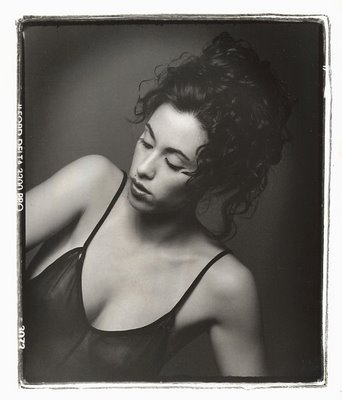
It is vivid and indelible in my memory. I was 7 or 8 years old and I was with my mother in a colectivo (a Buenos Aires bus). So vivid is my memory that I remember that we were on the fashionable Calle Esmeralda. A woman got on the bus with a little creature in tow. He or she was wearing a dress but he or she had very short hair (a crew cut). I could not decide if this was a boy dressed as a girl or some kind of strange girl. When I was that age the difference between the sexes was obvious. Boys wore short pants and men wore long pants. Girls and women wore dresses or skirts. When my mother took me to see a film with Katherine Hepburn I was most confused. Here was a woman who almost had a man's voice. And she wore pants. Not long after a little American girl came to my house to play and asked me if I wanted to see it. It was then that all my confusion about the sexes began.

Now that the 20th century has slipped into the 21st it seems obvious that skirts and dresses will go the way of Body by Fisher.
That is why I long for the nostalgia of my past in Argentina where in my imagination (perhaps) women were women and I was never confused (except for that little girl who must have had very thin hair). I can relive that nostalgia by glancing through the files of Linda Lorenzo.
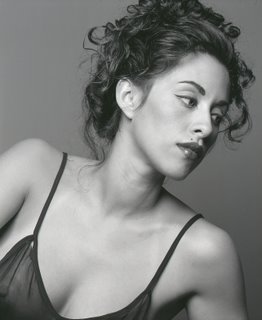
This Argentine beauty posed for Juan Manuel Sanchez, Nora Patrich and me in my studio or in Nora's house for over a year. We drank mate, spoke Argentine Spanish and relived a life when everything was in its proper (for us) place.
Juan asked Linda to pose with a guitar. I was appalled at his cliché on how a guitar resembles a woman. But Linda posed and I snapped my picture and joked with Juan. Now that Juan and Nora are divorced and live in separate aparments in Buenos Aires with new partners I would be prepared to photograph whatever cliché Juan could cook up just to share the comfort and joy of gazing at a woman who is woman.
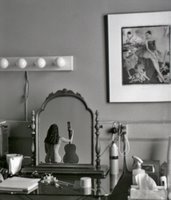
On Friday I am going to the the end of the school year performance of the Arts Umbrella senior and junior dance companies at the Vancouver Playhouse with Lauren and Rebecca. I have expressly asked them to wear dresses. Rebecca was reluctant but she agreed. What joy!
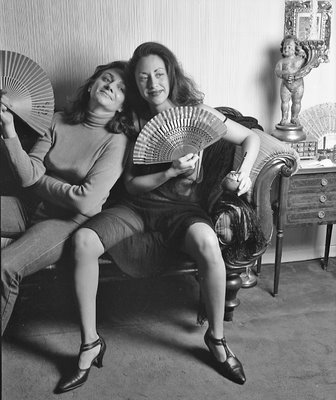
Some years back I spent lots of time at Juan Manuel Sanchez and Nora Patrich's house. My wife started suspecting something and asked me bluntly. I responded in a way she was not expecting and I wrote about it here. Rosemary then accepted my daily mate journey to Nora's and our constant telephone communication. Rosemary knew it was good for my soul and for my artistic morale.
But these good things ended when Nora and Juan divorced and both moved to Buenos Aires. Juan has an younger mistress and Nora has found a man in politics who shares the leftist leanings of her "causa". Nora and Juan don't see each other and rarely communicate.
When I have Rebecca in the car and I am taking her home the route passes by Nora and Juan's old house. One of Nora's daughters still lives there. Rebecca notices Juan and Nora's paintbrushes (in bottles) by the windows and a couple of little Argentine flags. Rebecca knows and doesn't ask. She knows how I miss them because she misses them, too. She also misses sipping the hot and bitter mate, the smell of paint and the "alegría" of our conversations. Juan said he would not attempt to teach Rebecca to draw and paint until she were 11. Juan believed children should be allowed to paint with freedom and without adult restrictions until that age. It would be about now that Rebecca would have walked the two blocks for her lessons with Juan.
Nora was a different kettle of fish. She was impulsive yet calculating. I always made fun of her leftist philosophy while dependant on her Visa card to get Airmiles points. I called it "causa de tacita de thé" or a leftist cause while holding the delicate tea cup.
As a young teenager on her way to school Nora would pass by the taller (studio) of the famous Grupo Espartaco artist (Grupo Espartaco was a group of Argentine painters who protested the military juntas of Argentina with mural art) Juan Manuel Sanchez and she would spy at the paintings. In the mid 90s after marrying two previous men she finally married Juan Manuel Sanchez. She brought him to Vancouver where Juan, not able to speak the language became a penguin the arctic.
He was out of his element. As he looked out of the window of his taller on to Douglas Park he felt alienated in not being able to understand the game being played. I tried to explain but Juan never did understand or want to understand what baseball was. Juan is back to the city he loves but after having experienced some the the benefits of Canada and Vancouver like our health system or the fact that electricity is constant and communication dependable he is now perhaps a polar bear in the antarctic. Nonetheless he is able to walk down from the taller to the nearby pizzería El Cuartito and savour a porción with his beloved moscato (a very cold and very sweet wine that tastes like fine grape juice).
As time passes my disdain for of Nora's causa and her constant praise for the Cuban health system and her criticism of Bush (Bush was singlehandedly the cause of global warming) is fading. I think it was all hot air. Nora had suffered terrible face cancers and our Canadian health system had been kind to her. She and Juan had a wonderful show of joint murals (painted in my studio on large rolls of canvas) that went from one town to another in all the major provinces of Argentina. The tab was picked up by "the culturally disadvantaged" (as Nora and Juan often complained) Canadians. It was the Canadian embassy in Buenos Aires that promoted their art. The Argentine economy was much too poor and in disarray to fund culture.
And so I miss Juan but I also miss Nora. My bitterness at their ruining of my artistic life by leaving me alone is fading a bit and I am beginning to seek out other outlets. But that does not prevent me from basking in the memory of those wonderful times.
Here you see Nora Patrich and Linda Lorenzo in Nora's living room. That smile! Nora had props. "I need a violin," I would tell her and she would fish one out from somewhere. She had a collection of fans and old dresses. Dresses that made Linda look fabulous. Being in Nora's living room was inspiration enough for anything. Nora had some original Goya engravings on her wall, a Picasso on another. A whole wall housed art books in Spanish. The other photograph shows Nora's painting in her paradoxical style. She had a causa yet her paintings never showed what was wrong with the world. Her women seemed to be ideal women who had no cause and just stared out of the canvas in wonder at the beauty of our world. The position of her woman's hands represents the female sexual organ. Nora was very frank in her discussion of sex and political correctness was not part of her causa. The photograph attempts to display a Borgesian obsession with the labyrinth.

Linda is wearing a Mexican rebozo that was given to my mother by her sister Dolly in 1951. It is made of raspy and rough cotton and the red dye is a brilliant vegetable dye. It smells of the Indian sandalwood chest I store it in.
And below is a photograph that combines all the paintings and the labyrinths we could muster.
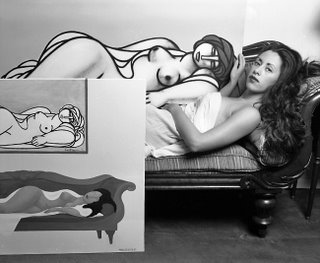
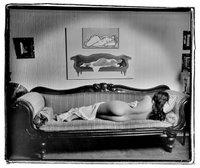
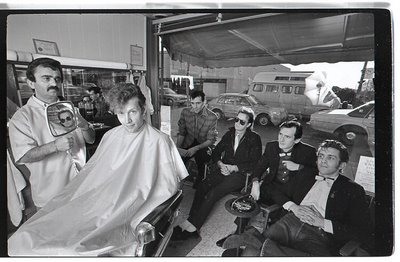
I know very few people in Vancouver who have a memory for buildings that are gone or for buildings that have been modified. A pleasant exception is my friend architect Henry Hawthorn.
Few who might find themselves at the corner of Fir and West Broadway would suspect that the strange white building that is now the Philippino bakery Goldilocks (the largest bakery chain in the world), used to house est (Erhard Seminars Training). Encounter sessions would be far livelier with Magnolia macapunú ice cream on the side.
In 1982 I photographed a revival rockabilly band Buddy Selfish & His Saviours in what for many years seemed to be a permanent fixture of our city. An Italian gentleman (an Italian version of Dorian Gray as he always looked the same) had a barbershop on the corner of Commercial Drive and 1st Avenue. Perhaps only two or three years ago it became a Mexican fast food restaurant (a very good one).
When I stop at this corner I think of the Ian Tiles (sitting on the barber chair) and the other members of the band. On the far right is Colin Griffiths (ex-UJ3RK5), then Bob Pettersen, Nick Jones (ex-Pointed Sticks) and Andy Grafitti (ex-UJ3RK5).
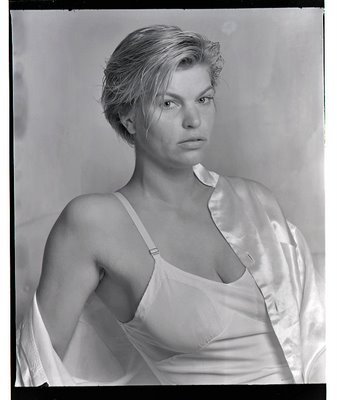
Some years ago I read a book of short stories by Milan Kundera. One of the stories has remained in my memory.
A young married couple living in the former Eastern Block country in Europe have to plan their vacation ahead. They finally get permission and they are driving to their resort destination. They are slightly bored so the woman suggests that they stop for gasoline and play a game. He is to gas up and then she will walk further on a pretend that she is thumbing a ride. He agrees. He picks her up and the game gets vicious when they say things to each other that they would otherwise have never said. He thinks she plays too easy, she thinks he is a sexist pig.
That story has remained in my memory because I associate it with a Polanski's classic 1962 film Knife in the Water. I saw it in the Israeli Cultural Institute in Mexico City sometime in 1964. In this film a couple on their way to a weekend escape in their boat, pick up a male hitchhiker and invite him to their boat. A rivalry insues for the attentions of the woman.
There is something European about the story and the film. While I have seen every film Charlotte Rampling (the quintessential European woman) I thought she was a fish out of water in the 1982 American film The Verdict with Paul Newman. Her "Europeaness" was diluted.
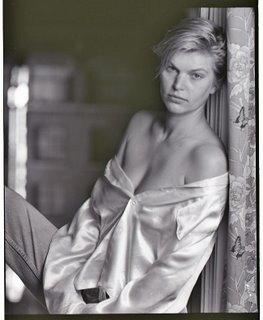
Norwegian film lighting technician Karethe Linnaae oozes European. Her accent is just right and her voice low enough to instantly alert you to her presence. She is the kind of woman that if you invite her to a bar/restaurant (the Railway Club on Dunsmuir, for example) men (and women) will ask me, "Who is she?" I can imagine a knife fight over her and Kundera would write a story about Karethe if he ever met her. He would write how she is a wrench in any mixture of men and how they will abandon all pretenses of fair play and gentlemanly behaviour to attract her attention.
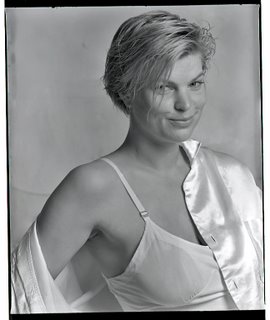
While I have not seen her for a long while I remember her easy smile and her warmth. I am grateful to have met her.

I first met up with the "Three Musketeers" (my name for them), Kim Collier, Jonathan Young and Kevin Kerr, founding members (1996) of the Electric Theatre Company in 2001. I was comissioned by them to take pictures of the actors involved in a play adapted by Vancouver's Carmen Aguirre from Jorge Amado's novel, Donna Flor and Her Two Husbands. The project also involved Argentine artists Nora Patrich and Juan Manuel Sanchez. On opening night, in the reception are of the East Vancouver Cultural Centre, Patrich, Sanchez and I had photographs, paintings, sketches with photographs and other variations that showed the characters of the play in their roles. It was the Electric Theatre Company that probably innaugurated the East Vancouver Cultural Centre tradition of having at least one production per year (be it a play or a dance performance) featuring full nudity. In fact it was Dona Flor's first husband (Ty Olson) who made the Vancouver theatre audience receptive to having a man on stage nude and dangle his parts for most of a performance. Carmen Aguirre was Dona Flor. She shed her clothes for the last act.
I dealt with them in 2003 for The Fall . It is hard to distinguish who acts, who directs and who writes the company's plays. I do believe that Kevin Kerr does not act. He is a playwright who won the Governor General's Literary Award in 2002 for his play Unity (1918) but both Collier and Young (married to each other, photo above, left) write, act and Collier directs. All three happily co-write many of the company's plays.

In 2006 the company staged Studies in Motion written by Kevin Kerr (right) that was based on the story of photographer Eadweard Muybridge. This wonderful play (nudity but this time at UBC's Frederic Wood Theatre) broke new grounds as all movement was choreographed by Kidd Pivot's Crystal Pite. After seeing this play I thought that theatre would never be quite same again for me. And that has been so. The Electric Theatre Company keeps challenging this concept of what theatre should or can be.
Last night Rosemary and I were challenged but entertained in the company's performance of Jean-Paul Sartre's No Exit. Both Rosemary and I had read the play many times but we have never seen it performed. No subsequent staging that we might see elsewhere will be able to match the bells, the whistles and the sheer technical wizardry of this production. And Kim Collier's direction was tight and to the point. Stuff had to be edited out. As an example when I spotted Crystal Pite I asked her, "How would you have choroegraphed this play? How would you have prevented the actors from ever blinking their eyes?" With a smile she answered, "I couldn't have." So any mention that the protagonists can never close their eyes was taken out from Paul Bowles' translation.
The three actors who are in "The Room", Laara Sadiq, Andy Thompson and Lucia Frangione show no redeeming qualities (terrific acting) and thus show why they are in hell. I never felt sorry for them and I now understand why my theology class before lunch in my Catholic boarding school in Texas seemed like hell. As we would say in Spanish, it was an antesala del infierno or ante room to hell. The class seemed like it would never end.
But it was Jonathan Young's performance as the valet that I enjoyed the best. Last year I thought his Ruby Slippers paticipation in Trout Stanley was the best performance by a male actor that I have seen in years. And Rosemary still talks about his acting in the company's 2004 play, Palace Grand (picture here of Young smoking a joint).
Young is a handsome actor. But he is slim and almost as small as Collier. He can (I am sure) almost make himself disappear so you won't notice him. And he rarely yells. You pay attention because you want to listen to him. In No Exit, while I didn't give a damn what happened to the three in the room I felt anguish for Young's valet who it would seem will have to spend an eternity dealing with people of no consequence. A worse hell I cannot imagine.
By accident I saw the CBC film (2004) A Bear Named Winnie on TV over the weekend. It is based on the true story of a Canadian soldier, enroute to World War I from Winnipeg, who adopts an orphaned bear cub at White River Ontario. It is named Winnie (for Winnipeg) and eventually ends up at the London Zoo where it became the inspiration for A.A.Milne's Winnie The Pooh stories. He is fussed over by two men. One of them is Jonathan Young who plays a veterinarian soldier called Macray. It was in this film (a film that shows that the CBC can deliver good Canadian goods when it wants to) that I noticed Young's chameleon qualities. But it was this line in the film that stopped me and made me notice, "I know everything, I have done nothing."

There is more. The three musketeers met while studying theatre at Langara's Studio 58. Carmen Aguirre studied there and has written plays for it including a most entertaining adaptation of Argentine writer Julio Cortazar's story The Rules of the Game.
A few weeks back I photographed Antony Holland who was the founder of Studio 58. His latest project is minimalist theatre. He believes that strong plays don't need staging or props. He would perhaps not approve of the Electric Theatre Company's No Exit. I would only say to this gentle man that more than anybody in Vancouver he is singly responsible for the machinations of his students. They will perhaps some day return to his minimalism. Meanwhile he should take some credit for the sheer brilliance of those whom he has inspired.
Luckily for the other theatre companies of our city, these three musketeers are only three. Were they four there would be no competition.
Addendum
Hey everyone! Just wanted to let you all know that I will be doing a public reading of Blue Box, my new play, during The New Play Festival, which takes place during Magnetic North, the national theatre festival being held in Vancouver this year.
Blue Box is a one-woman autobiographical dark comedy about sex and politics. Can there be sex without politics? Can there be politics without sex? The play takes place in the Third and First worlds, from the eighties into the new millenium, during revolutionary and post-revolutionary times.
Here's the info:
Blue Box, written and performed by Carmen Aguirre, directed by Brian Quirt.
A Nightswimming commission.
When: Wednesday, June 11th, at 9pm
Where: Playwrights Theatre Centre Studio at Festival House on Granville Island. 1398 Cartwright Street, a few doors down from The Waterfront Theatre.
Admission: $5 at the door.
Would love to see you all there! Please pass it on.... Carmen Aguirre:)
A Nostalgia For Women In Skirts & Dresses
Thursday, May 08, 2008

It is vivid and indelible in my memory. I was 7 or 8 years old and I was with my mother in a colectivo (a Buenos Aires bus). So vivid is my memory that I remember that we were on the fashionable Calle Esmeralda. A woman got on the bus with a little creature in tow. He or she was wearing a dress but he or she had very short hair (a crew cut). I could not decide if this was a boy dressed as a girl or some kind of strange girl. When I was that age the difference between the sexes was obvious. Boys wore short pants and men wore long pants. Girls and women wore dresses or skirts. When my mother took me to see a film with Katherine Hepburn I was most confused. Here was a woman who almost had a man's voice. And she wore pants. Not long after a little American girl came to my house to play and asked me if I wanted to see it. It was then that all my confusion about the sexes began.

Now that the 20th century has slipped into the 21st it seems obvious that skirts and dresses will go the way of Body by Fisher.
That is why I long for the nostalgia of my past in Argentina where in my imagination (perhaps) women were women and I was never confused (except for that little girl who must have had very thin hair). I can relive that nostalgia by glancing through the files of Linda Lorenzo.

This Argentine beauty posed for Juan Manuel Sanchez, Nora Patrich and me in my studio or in Nora's house for over a year. We drank mate, spoke Argentine Spanish and relived a life when everything was in its proper (for us) place.
Juan asked Linda to pose with a guitar. I was appalled at his cliché on how a guitar resembles a woman. But Linda posed and I snapped my picture and joked with Juan. Now that Juan and Nora are divorced and live in separate aparments in Buenos Aires with new partners I would be prepared to photograph whatever cliché Juan could cook up just to share the comfort and joy of gazing at a woman who is woman.

On Friday I am going to the the end of the school year performance of the Arts Umbrella senior and junior dance companies at the Vancouver Playhouse with Lauren and Rebecca. I have expressly asked them to wear dresses. Rebecca was reluctant but she agreed. What joy!
A Nostalgia For Women In Skirts, Dresses & Nora Patrich

Some years back I spent lots of time at Juan Manuel Sanchez and Nora Patrich's house. My wife started suspecting something and asked me bluntly. I responded in a way she was not expecting and I wrote about it here. Rosemary then accepted my daily mate journey to Nora's and our constant telephone communication. Rosemary knew it was good for my soul and for my artistic morale.
But these good things ended when Nora and Juan divorced and both moved to Buenos Aires. Juan has an younger mistress and Nora has found a man in politics who shares the leftist leanings of her "causa". Nora and Juan don't see each other and rarely communicate.
When I have Rebecca in the car and I am taking her home the route passes by Nora and Juan's old house. One of Nora's daughters still lives there. Rebecca notices Juan and Nora's paintbrushes (in bottles) by the windows and a couple of little Argentine flags. Rebecca knows and doesn't ask. She knows how I miss them because she misses them, too. She also misses sipping the hot and bitter mate, the smell of paint and the "alegría" of our conversations. Juan said he would not attempt to teach Rebecca to draw and paint until she were 11. Juan believed children should be allowed to paint with freedom and without adult restrictions until that age. It would be about now that Rebecca would have walked the two blocks for her lessons with Juan.
Nora was a different kettle of fish. She was impulsive yet calculating. I always made fun of her leftist philosophy while dependant on her Visa card to get Airmiles points. I called it "causa de tacita de thé" or a leftist cause while holding the delicate tea cup.
As a young teenager on her way to school Nora would pass by the taller (studio) of the famous Grupo Espartaco artist (Grupo Espartaco was a group of Argentine painters who protested the military juntas of Argentina with mural art) Juan Manuel Sanchez and she would spy at the paintings. In the mid 90s after marrying two previous men she finally married Juan Manuel Sanchez. She brought him to Vancouver where Juan, not able to speak the language became a penguin the arctic.
He was out of his element. As he looked out of the window of his taller on to Douglas Park he felt alienated in not being able to understand the game being played. I tried to explain but Juan never did understand or want to understand what baseball was. Juan is back to the city he loves but after having experienced some the the benefits of Canada and Vancouver like our health system or the fact that electricity is constant and communication dependable he is now perhaps a polar bear in the antarctic. Nonetheless he is able to walk down from the taller to the nearby pizzería El Cuartito and savour a porción with his beloved moscato (a very cold and very sweet wine that tastes like fine grape juice).
As time passes my disdain for of Nora's causa and her constant praise for the Cuban health system and her criticism of Bush (Bush was singlehandedly the cause of global warming) is fading. I think it was all hot air. Nora had suffered terrible face cancers and our Canadian health system had been kind to her. She and Juan had a wonderful show of joint murals (painted in my studio on large rolls of canvas) that went from one town to another in all the major provinces of Argentina. The tab was picked up by "the culturally disadvantaged" (as Nora and Juan often complained) Canadians. It was the Canadian embassy in Buenos Aires that promoted their art. The Argentine economy was much too poor and in disarray to fund culture.
And so I miss Juan but I also miss Nora. My bitterness at their ruining of my artistic life by leaving me alone is fading a bit and I am beginning to seek out other outlets. But that does not prevent me from basking in the memory of those wonderful times.
Here you see Nora Patrich and Linda Lorenzo in Nora's living room. That smile! Nora had props. "I need a violin," I would tell her and she would fish one out from somewhere. She had a collection of fans and old dresses. Dresses that made Linda look fabulous. Being in Nora's living room was inspiration enough for anything. Nora had some original Goya engravings on her wall, a Picasso on another. A whole wall housed art books in Spanish. The other photograph shows Nora's painting in her paradoxical style. She had a causa yet her paintings never showed what was wrong with the world. Her women seemed to be ideal women who had no cause and just stared out of the canvas in wonder at the beauty of our world. The position of her woman's hands represents the female sexual organ. Nora was very frank in her discussion of sex and political correctness was not part of her causa. The photograph attempts to display a Borgesian obsession with the labyrinth.

Linda is wearing a Mexican rebozo that was given to my mother by her sister Dolly in 1951. It is made of raspy and rough cotton and the red dye is a brilliant vegetable dye. It smells of the Indian sandalwood chest I store it in.
And below is a photograph that combines all the paintings and the labyrinths we could muster.


Buddy Selfish & His Saviours - A Taco On The Barber Chair
Wednesday, May 07, 2008

I know very few people in Vancouver who have a memory for buildings that are gone or for buildings that have been modified. A pleasant exception is my friend architect Henry Hawthorn.
Few who might find themselves at the corner of Fir and West Broadway would suspect that the strange white building that is now the Philippino bakery Goldilocks (the largest bakery chain in the world), used to house est (Erhard Seminars Training). Encounter sessions would be far livelier with Magnolia macapunú ice cream on the side.
In 1982 I photographed a revival rockabilly band Buddy Selfish & His Saviours in what for many years seemed to be a permanent fixture of our city. An Italian gentleman (an Italian version of Dorian Gray as he always looked the same) had a barbershop on the corner of Commercial Drive and 1st Avenue. Perhaps only two or three years ago it became a Mexican fast food restaurant (a very good one).
When I stop at this corner I think of the Ian Tiles (sitting on the barber chair) and the other members of the band. On the far right is Colin Griffiths (ex-UJ3RK5), then Bob Pettersen, Nick Jones (ex-Pointed Sticks) and Andy Grafitti (ex-UJ3RK5).
Karethe Linnaae - Knife Out Of Water
Tuesday, May 06, 2008

Some years ago I read a book of short stories by Milan Kundera. One of the stories has remained in my memory.
A young married couple living in the former Eastern Block country in Europe have to plan their vacation ahead. They finally get permission and they are driving to their resort destination. They are slightly bored so the woman suggests that they stop for gasoline and play a game. He is to gas up and then she will walk further on a pretend that she is thumbing a ride. He agrees. He picks her up and the game gets vicious when they say things to each other that they would otherwise have never said. He thinks she plays too easy, she thinks he is a sexist pig.
That story has remained in my memory because I associate it with a Polanski's classic 1962 film Knife in the Water. I saw it in the Israeli Cultural Institute in Mexico City sometime in 1964. In this film a couple on their way to a weekend escape in their boat, pick up a male hitchhiker and invite him to their boat. A rivalry insues for the attentions of the woman.
There is something European about the story and the film. While I have seen every film Charlotte Rampling (the quintessential European woman) I thought she was a fish out of water in the 1982 American film The Verdict with Paul Newman. Her "Europeaness" was diluted.

Norwegian film lighting technician Karethe Linnaae oozes European. Her accent is just right and her voice low enough to instantly alert you to her presence. She is the kind of woman that if you invite her to a bar/restaurant (the Railway Club on Dunsmuir, for example) men (and women) will ask me, "Who is she?" I can imagine a knife fight over her and Kundera would write a story about Karethe if he ever met her. He would write how she is a wrench in any mixture of men and how they will abandon all pretenses of fair play and gentlemanly behaviour to attract her attention.

While I have not seen her for a long while I remember her easy smile and her warmth. I am grateful to have met her.
Monday, May 05, 2008
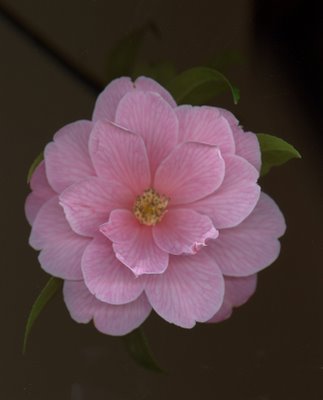
It appreared in about 1941, raised by Colonel Stevenson Clark of Sussex, England, by crossing Camellia saluenensis with Camellia japonica ’Masayoshi’
I have written about camellias and this particular one here. When I look at camellias I think of my boarding school days at St. Edwards in Austin, Texas in the late 50s. The only woman on campus was an older and large black woman who worked in our cafeteria kitchen. Our only contact with members of the female sex where in the basketball and football games. The girls from the other side of the city, St Mary's attended and some of them were our cheerleaders. I was much too shy to talk to them (and Judy Reyes, below, in particular) and since I didn't know how to dance I rarely met any of them at our occasional sock hops in our basketball gym.
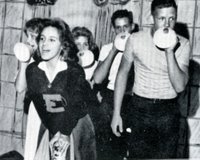
There was one woman (there were others, but I remember in particular this one) who knew the number of our pay phone at the end of our dormitory hall. Her name was Marion and she would call and we would talk to her for hours. She led us on (I would use a the term that was in vogue then, she was a p---- teaser ). She had a pleasant sexy voice and was never crude. She was a solace in those in-between days before they let us out for all day passes in town on Saturdays and Sundays.
I would first go to 6th Street where there was a pocket book store. After buying a Frank G. Slaughter pocket novel. The medical novels had lots of terrific sex in them. I did not feel guilty in reading them as my mother loved this author. And one title in particular, Dear And Glorious Physician was about St Luke even though there were lots of sexual shenanigans in Bithynia!
Then I would walk to the Stephen F. Austin Hotel on Congress Avenue and I would gaze (while spooning my favourite ice cream, vanilla with real cherry bits) on the lovely soda jerk who worked behind the soda fountain counter. She was blonde and I imagined she was Eva Marie Saint. I had fallen for her (and ignored Elizabeth Taylor's violet eyes) when I had seen Raintree County in the movie house, next door.
Camellias are like Marion and the soda jerk at the Stephen F. Austin. They dazzle, they promise but don't deliver. Camellias have all the promise of my roses that begin to bloom at the end of May. Some of my roses even resemble camellias. But they also deliver with scent. Many are remontant and don't just bloom and quickly fade away as camellias do.
But my camellias do offer me solace for those in-between days of May. Before my roses finally deliver.

One of the perils of opening one's garden to a tour is that even if I tell Rosemary that nobody is going to bother to look at the outside of the house she worries that people will do just that. Since we moved to our house on Athlone Street in 1986 we have only had our house painted once. And it was a nerve racking experience. The only way you can paint our house is to do so in the waning days of summer, after we simply say to ourselves, "Let the painters step on anything. The plants will come back next year." To paint our house or even approach a cosmetic "paint the flaws" approach now is at best a compromise. These cosmetic touches cannot be applied until the weather is warm enough and dry enough for the paint to stick. This means the plants (including delicate ferns and emerging hostas) will suffer the fearsome effects of our local Attilas who have no idea of their fragile nature.
Yesterday was one of the most stressful days in memory for us as our Bosnian Attila trampled back and forth while painting with finesse the peeling stucco that had been "gently" removed by his German Attila cohort with 2200psi. To be fair no painter that I know would have accepted such a job that involved placing ladders in almost dangerous angles when scaffolding should have been erected. Worst of all we could not spend much time with Rebecca who given no direction will end up dressing dolls on the computer or watching TV. Lauren, on the other hand stayed outside talking to our Bosnian Attila. He talks even when we are not nearby. Here he finally found his match and he warmed up to her. Considering that he is poised to be a grandfather by December this bodes well. He is gentle with children even if with us he complains of the working conditions, the cold , the rain and our impossible demands.
Lauren spent the day outside while asking me questions on absolutely everything. I kept thinking while showing much patience and restraint, "Go and talk to him."
But both Rosemary and I know that when the visitors from the home and gardens (one garden, ours!) Ballet BC tour come at the end of the month the garden will be as ready as it can possibly be. Both Rebecca and Lauren will be wearing dresses and, if weather permits, they will be barefoot. I will teach Lauren the names of some plants (Rebecca knows many already) and they will be our hostesses while se sit down and enjoy the hordes of visitors (anywhere between 1500 and 2000). Stressful times will be in the past and even though Rosemary said, "Never again," I am sure that if someone calls to ask us if we will open the garden next year...

I have been re-reading Alexandre Dumas to satisfy my appetite for swashbuckler novels. Then I discovered Jack Absolute.
Former actor, schoolboy fencing champion and author (six novels and three plays) C.C. Humphreys was a few minutes late to my studio. He had decided to drive not walk. He was concerned he might be stopped on the way. He was bringing a cavalry sabre.
In 1987 in the opening night of the eighteenth-century comedy, Richard Sheridan's The Rivals in London, actor Humphreys played protagonist Jack Absolute, a young swashbuckler rake. In Humphreys 2003 novel, Jack Absolute , Jack goes to see the The Rivals and learns that Sheridan has stolen his name and made him the star of his comedy.
In Humphreys's third in the series, Absolute Honour (2006, the second was the 2004 prequel The Blooding of Jack Absolute ) Humphreys borrows back from Sheridan and incorporates part of the plot of The Rivals.
Canadian born, but British educated, Humphreys understands the importance of the Plains of Abraham in the making of Canada. In The Blooding of Jack Absolute Jack is a 16-year-old boy who fights in that battle. During his research Humphreys climbed up that back way to the Quebec City plains in training shoes. "It's not vertical but at 70 degrees it must have been difficult. Every time you place your foot it is treacherous and you slip. What would it have been like in boots, pack and musket? At the top there are two signs. The one in English stated that this was the path the British Light Infantry came up at two in the morning. The one in French hints that Wolfe snuck up and with superior naval power won the day. Which is bonks! The navy was not involved."
Humphreys the actor became obsessed with Absolute to create the protagonist of his novels. He also has played Hamlet enough times to find an equal attraction to the role. Of Hamlet he said to me, "It is the ultimate straight role. Whatever stuff you bring from your life, that's who Hamlet is on stage. It is a personal journey. It exposes a lot of your own things and stuff." In the Blooding of Jack Absolute Jack winters in a cave with a Mohawk called Até. He teaches him to read with the only book in hand, a cheap copy of Shakespeare's tragedy.
With lots of twists and turns, spies and sword fights(complex ones involving left handers), Humphreys satisfies my hunger for reading adventure. Now as a late Canadian citizen, I understand how the battle that made Canada was fought. I asked Humphreys what role a swachbuckler plays in the 21st century. "It is as ever it was. It is to give an example of someone who is engages in the pursuit of honour, justice and is prepared to risk all at the point of a sword to gain everything."

Humphreys has also published the novel The French Executioner (about the man who lopped off Anne Boleyn's head). For those who cannot wait for the next Jack Absolute they will have to wait longer. In October 2008 McArthur & Co. will be publishing Humphrey's novel about the true historical Dracula, Vlad: The Last Confession. Humphreys lives in Vancouver whith his wife and son. His website is: cchumphreys.com
© 2008 VLM/Alex Waterhouse-Hayward

It appreared in about 1941, raised by Colonel Stevenson Clark of Sussex, England, by crossing Camellia saluenensis with Camellia japonica ’Masayoshi’
I have written about camellias and this particular one here. When I look at camellias I think of my boarding school days at St. Edwards in Austin, Texas in the late 50s. The only woman on campus was an older and large black woman who worked in our cafeteria kitchen. Our only contact with members of the female sex where in the basketball and football games. The girls from the other side of the city, St Mary's attended and some of them were our cheerleaders. I was much too shy to talk to them (and Judy Reyes, below, in particular) and since I didn't know how to dance I rarely met any of them at our occasional sock hops in our basketball gym.

There was one woman (there were others, but I remember in particular this one) who knew the number of our pay phone at the end of our dormitory hall. Her name was Marion and she would call and we would talk to her for hours. She led us on (I would use a the term that was in vogue then, she was a p---- teaser ). She had a pleasant sexy voice and was never crude. She was a solace in those in-between days before they let us out for all day passes in town on Saturdays and Sundays.
I would first go to 6th Street where there was a pocket book store. After buying a Frank G. Slaughter pocket novel. The medical novels had lots of terrific sex in them. I did not feel guilty in reading them as my mother loved this author. And one title in particular, Dear And Glorious Physician was about St Luke even though there were lots of sexual shenanigans in Bithynia!
Then I would walk to the Stephen F. Austin Hotel on Congress Avenue and I would gaze (while spooning my favourite ice cream, vanilla with real cherry bits) on the lovely soda jerk who worked behind the soda fountain counter. She was blonde and I imagined she was Eva Marie Saint. I had fallen for her (and ignored Elizabeth Taylor's violet eyes) when I had seen Raintree County in the movie house, next door.
Camellias are like Marion and the soda jerk at the Stephen F. Austin. They dazzle, they promise but don't deliver. Camellias have all the promise of my roses that begin to bloom at the end of May. Some of my roses even resemble camellias. But they also deliver with scent. Many are remontant and don't just bloom and quickly fade away as camellias do.
But my camellias do offer me solace for those in-between days of May. Before my roses finally deliver.
Trampling Huns & Little Girl Hostesses
Sunday, May 04, 2008

One of the perils of opening one's garden to a tour is that even if I tell Rosemary that nobody is going to bother to look at the outside of the house she worries that people will do just that. Since we moved to our house on Athlone Street in 1986 we have only had our house painted once. And it was a nerve racking experience. The only way you can paint our house is to do so in the waning days of summer, after we simply say to ourselves, "Let the painters step on anything. The plants will come back next year." To paint our house or even approach a cosmetic "paint the flaws" approach now is at best a compromise. These cosmetic touches cannot be applied until the weather is warm enough and dry enough for the paint to stick. This means the plants (including delicate ferns and emerging hostas) will suffer the fearsome effects of our local Attilas who have no idea of their fragile nature.
Yesterday was one of the most stressful days in memory for us as our Bosnian Attila trampled back and forth while painting with finesse the peeling stucco that had been "gently" removed by his German Attila cohort with 2200psi. To be fair no painter that I know would have accepted such a job that involved placing ladders in almost dangerous angles when scaffolding should have been erected. Worst of all we could not spend much time with Rebecca who given no direction will end up dressing dolls on the computer or watching TV. Lauren, on the other hand stayed outside talking to our Bosnian Attila. He talks even when we are not nearby. Here he finally found his match and he warmed up to her. Considering that he is poised to be a grandfather by December this bodes well. He is gentle with children even if with us he complains of the working conditions, the cold , the rain and our impossible demands.
Lauren spent the day outside while asking me questions on absolutely everything. I kept thinking while showing much patience and restraint, "Go and talk to him."
But both Rosemary and I know that when the visitors from the home and gardens (one garden, ours!) Ballet BC tour come at the end of the month the garden will be as ready as it can possibly be. Both Rebecca and Lauren will be wearing dresses and, if weather permits, they will be barefoot. I will teach Lauren the names of some plants (Rebecca knows many already) and they will be our hostesses while se sit down and enjoy the hordes of visitors (anywhere between 1500 and 2000). Stressful times will be in the past and even though Rosemary said, "Never again," I am sure that if someone calls to ask us if we will open the garden next year...
C.C. Humphreys - Absolute Sword Player
Saturday, May 03, 2008

I have been re-reading Alexandre Dumas to satisfy my appetite for swashbuckler novels. Then I discovered Jack Absolute.
Former actor, schoolboy fencing champion and author (six novels and three plays) C.C. Humphreys was a few minutes late to my studio. He had decided to drive not walk. He was concerned he might be stopped on the way. He was bringing a cavalry sabre.
In 1987 in the opening night of the eighteenth-century comedy, Richard Sheridan's The Rivals in London, actor Humphreys played protagonist Jack Absolute, a young swashbuckler rake. In Humphreys 2003 novel, Jack Absolute , Jack goes to see the The Rivals and learns that Sheridan has stolen his name and made him the star of his comedy.
In Humphreys's third in the series, Absolute Honour (2006, the second was the 2004 prequel The Blooding of Jack Absolute ) Humphreys borrows back from Sheridan and incorporates part of the plot of The Rivals.
Canadian born, but British educated, Humphreys understands the importance of the Plains of Abraham in the making of Canada. In The Blooding of Jack Absolute Jack is a 16-year-old boy who fights in that battle. During his research Humphreys climbed up that back way to the Quebec City plains in training shoes. "It's not vertical but at 70 degrees it must have been difficult. Every time you place your foot it is treacherous and you slip. What would it have been like in boots, pack and musket? At the top there are two signs. The one in English stated that this was the path the British Light Infantry came up at two in the morning. The one in French hints that Wolfe snuck up and with superior naval power won the day. Which is bonks! The navy was not involved."
Humphreys the actor became obsessed with Absolute to create the protagonist of his novels. He also has played Hamlet enough times to find an equal attraction to the role. Of Hamlet he said to me, "It is the ultimate straight role. Whatever stuff you bring from your life, that's who Hamlet is on stage. It is a personal journey. It exposes a lot of your own things and stuff." In the Blooding of Jack Absolute Jack winters in a cave with a Mohawk called Até. He teaches him to read with the only book in hand, a cheap copy of Shakespeare's tragedy.
With lots of twists and turns, spies and sword fights(complex ones involving left handers), Humphreys satisfies my hunger for reading adventure. Now as a late Canadian citizen, I understand how the battle that made Canada was fought. I asked Humphreys what role a swachbuckler plays in the 21st century. "It is as ever it was. It is to give an example of someone who is engages in the pursuit of honour, justice and is prepared to risk all at the point of a sword to gain everything."

Humphreys has also published the novel The French Executioner (about the man who lopped off Anne Boleyn's head). For those who cannot wait for the next Jack Absolute they will have to wait longer. In October 2008 McArthur & Co. will be publishing Humphrey's novel about the true historical Dracula, Vlad: The Last Confession. Humphreys lives in Vancouver whith his wife and son. His website is: cchumphreys.com
© 2008 VLM/Alex Waterhouse-Hayward
Friday, May 02, 2008
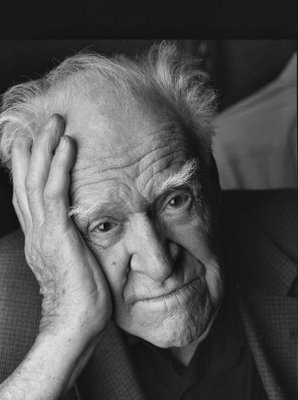
Rosemary and I attended last night the opening performance of Mitch Albom and Jeffrey Hatcher's play Tuesdays with Morrie. It was an Arts Club Theatre Production on the Granville Island Stage. It was an exquisitely excruciating experience.
It was that much more excruciating for me because I had the pleasure of taking Antony Holland's (he plays Morrie to Warren Kimmel's Mitch) portrait, left, last Thursday. Holland was 88 on March 28th. When he faced my camera it was obvious that here was a man who is in full control of all of his faculties including a keen sense of humour and a phenomenal memory. The only flaw I could detect was an extraordinary sweet tooth. He is much younger than his 88 years.
To see Holland's character Morrie (who is suffering the terminally degenerative Lou Gehrig's disease) break down on stage and slowly descend from dancing, to using a walker, to sitting in a wheel chair, to having to use a reclining sofa and then further degenerating into the pallid emaciated old man who is bedridden was a tour the force for me.
This tour de force was equaled by Warren Kimmel's performance as an ambitious, cold, calculating sports writer who somehow by the end of the play breaks down (pushed by his mentor Morrie) and becomes a whole human being. He was so despicable that I even noticed his loathsome light brown Italian shoes. Had I met him on the street with him wearing those shoes I would have instantly disliked him. Such is the power of good acting.
Such is the power of good acting that the play brought to mind a favourite science fiction novel that I had read in the 60s called More Than Human by Theodore Sturgeon. Somehow as Mitch broke down mentally while his mentor Morrie broke down physically that combination added to "more than human" and gave this depressing play (I laughed lots in the first act) a cathartic saving grace.
Curiously a play with such complexity of feelings had friend and VLM editor Bob Mercer and I wondering if Warren Kimmel was really playing that wonderful jazz piano. Mercer who probably told both his younger brothers that Santa Claus did not exist thought the piano playing was a recording. I was convinced that Kimmel's considerable acting abilities included playing a damn good jazz piano. So we asked an usher who told us, "I really was not here during the first 15 minutes (a patent lie) so I don't know. Kimmel is talented so he certainly could have been playing it." I was not satisfied so while waiting back stage to talk to Holland I asked the stage manager who answered, "I really cannot tell you as I have not noticed if he plays the piano. It is possible."

So I warned Holland how the two previous persons had been ambiguous in answering my question. I asked, "Does Kimmel really play that piano?" Holland looked at me directly (and in character, or was it out of character? I could not make up my mind.) and he told me.
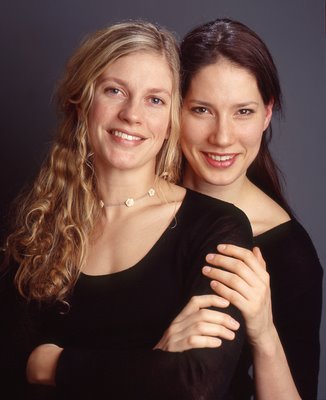
It has taken 65 years for my concept of space and time to change, even after having read here and there about Einsteinian time and space. It all suddenly changed for me some five years ago when Vancouver contemporary dancers Emily Molnar and Crystal Pite discussed space, time and movement in my studio.
The shortest definition of relativistic movement I have ever heard came from Molnar (35) who said, “Movement is the observer.” This means that from a position of rest we the observers can discern the movement of a dancer on stage. Of time Pite (37) said, “The ephemeral of dance exists only in the present movement. We are left with traces of movements that are gone as they are being created. As we carve space with our bodies they leave a ghost, the trail which affects our future moves and informs the observer of our past moves.” I then understood that those past moves are much like the contrails that high-flying jets leave in the sky.
In 1996 I photographed Crystal Pite who was leaving Ballet BC for William Forsythe’s Frankfurt Ballet. I had seen her Ballet BC farewell performance of her own work, Moving Day. I was amazed by her elegance and style but immediately saddened that I might not to see her dance again. In 1998 I photographed Emily Molnar who returned from the Frankfurt Ballet to assist John Alleyne’s direction of Ballet BC. Fortunately for us all Alleyne made her dance, too. In between, Pite and Molnar met and danced for two years in Frankfurt. Pite returned to Vancouver 6 years ago where she directs Kidd Pivot, her own dance company.
Rebecca, my precocious 10 year-old granddaughter with whom I attend as many ballet and modern dance performances as we can, may be well ahead of her lumbering grandfather. She has declared to me that her favourite Vancouver dancers are Crystal and Emily. We agree.
It was with Rebecca that I saw Pite do part of her full-length ballet for the Frankfurt Ballet called Field Fiction. On stage, assisted by the excellent Cori Caulfield, and dressed in a stylized military uniform she removed her Prussian type spiked helmet and inserted her head into a noose that hung from the ceiling. On her tiptoes she did an exquisite and alternately horrific interpretation of a man hanging. I can only imagine what the scope of the silence that followed this performance must have been when it premiered in Frankfurt. Behind me was Sylvain Senez, Ballet BC’s Ballet master whispered in my ear, “Crystal is the future of dance in Vancouver.”
When Molnar (she is striking at 5 ft 11in) entered my studio for her first picture in 1998 she quietly sat in a corner in a fetal position for 10 minutes before facing my camera. Since then, thanks to Molnar, Pite and the performances of some of William Forsythe’s works by Ballet BC I have come not only to appreciate why Forsythe’s choreography and his company were rated about best in the world but also why Molnar and Pite talk physics. Asked on how he pushes the boundaries of the form of dance Forsythe once said, “I don’t think so much of the body when we are doing this. We are thinking about ‘the thinking body’ or we’re trying to understand how the body thinks about its own presence.” Or the way the ever-succinct Molnar put it to me, “Dance requires the entire body and the mind.”
Molnar has her own company, Emily Molnar Dance. When possible I attend whatever performance of hers I can find. More often than not she is busy choreographing for companies in Europe and New York. I sometimes catch her rehearsing the senior dancers at Arts Umbrella on Saturdays. Her principal role performances for several of John Alleyne’s full-length works including The Faerie Queen and Scheherazade linger in my memory. On the rehearsal of the latter Rebecca first noticed her and insisted on meeting her. It was in Molnar’s solo performance of Speak choreographed for her by Margie Gillis that I finally fell hard for her. I had to photograph Molnar for a local publication and she offered to go through the whole performance (just for me!) so I could pick a dance move for the photograph. In such close proximity I learned how strenuous dance really is no matter how effortless a dancer makes it seem to be. I now sit in the front row for dance performances, as part of the rewards of watching dance is to be able to hear the dancers breathe. In retrospect when I think of Molnar and Speak and watching her long limbs I smile remembering what Pite says of her, “There is always this extreme quality of her movement. The extreme doesn’t come from her extremities, although the result is extreme. The extremity is internally motivated. The motivation comes from her core.”
For me watching Pite or Molnar dance (they have yet to dance together in Vancouver) puts other dancers with them at a disadvantage. Pite and Molnar stand out and the others just fade much in the same way as the Royal Winnipeg Ballet’s dancers used to disappear for me when I watched Evelyn Hart dance.
The uniqueness of Pite’s and Molnar’s style is perhaps best explained by Molnar’s take on Pite. "She is an artist of the highest caliber. She is defining dance in the future. She has a movement understanding that is absolutely three-dimensional. You know it’s Crystal when she dances, whether you see her face or not. There is uniqueness, creativity and a sense of humour in her statements. There is a grounded articulation in her physicality. There is no one like Crystal, and what that is, is still evolving." While Crystal’s definition of Molnar involves lots of physics I can safely say that Sylvain Senez was only half right. The future of dance in Vancouver is not only Crystal Pite but Emily Molnar, too.
It is a special delight when either Molnar or Pite appear in one of my favourite Vancouver dance programs, Dances for a Small Stage . The restraints of a small stage are a problem when you consider that both Pite and Molnar agree that when you, for example, throw an arm out, the distance cast is infinite. For a while, I selfishly hope, that their movements do not exceed beyond the borders of our fair and doubly lucky Vancouver.

Rosemary and I attended last night the opening performance of Mitch Albom and Jeffrey Hatcher's play Tuesdays with Morrie. It was an Arts Club Theatre Production on the Granville Island Stage. It was an exquisitely excruciating experience.
It was that much more excruciating for me because I had the pleasure of taking Antony Holland's (he plays Morrie to Warren Kimmel's Mitch) portrait, left, last Thursday. Holland was 88 on March 28th. When he faced my camera it was obvious that here was a man who is in full control of all of his faculties including a keen sense of humour and a phenomenal memory. The only flaw I could detect was an extraordinary sweet tooth. He is much younger than his 88 years.
To see Holland's character Morrie (who is suffering the terminally degenerative Lou Gehrig's disease) break down on stage and slowly descend from dancing, to using a walker, to sitting in a wheel chair, to having to use a reclining sofa and then further degenerating into the pallid emaciated old man who is bedridden was a tour the force for me.
This tour de force was equaled by Warren Kimmel's performance as an ambitious, cold, calculating sports writer who somehow by the end of the play breaks down (pushed by his mentor Morrie) and becomes a whole human being. He was so despicable that I even noticed his loathsome light brown Italian shoes. Had I met him on the street with him wearing those shoes I would have instantly disliked him. Such is the power of good acting.
Such is the power of good acting that the play brought to mind a favourite science fiction novel that I had read in the 60s called More Than Human by Theodore Sturgeon. Somehow as Mitch broke down mentally while his mentor Morrie broke down physically that combination added to "more than human" and gave this depressing play (I laughed lots in the first act) a cathartic saving grace.
Curiously a play with such complexity of feelings had friend and VLM editor Bob Mercer and I wondering if Warren Kimmel was really playing that wonderful jazz piano. Mercer who probably told both his younger brothers that Santa Claus did not exist thought the piano playing was a recording. I was convinced that Kimmel's considerable acting abilities included playing a damn good jazz piano. So we asked an usher who told us, "I really was not here during the first 15 minutes (a patent lie) so I don't know. Kimmel is talented so he certainly could have been playing it." I was not satisfied so while waiting back stage to talk to Holland I asked the stage manager who answered, "I really cannot tell you as I have not noticed if he plays the piano. It is possible."

So I warned Holland how the two previous persons had been ambiguous in answering my question. I asked, "Does Kimmel really play that piano?" Holland looked at me directly (and in character, or was it out of character? I could not make up my mind.) and he told me.
Emily Molnar, Crystal Pite - Eisteinian Space & Time
Thursday, May 01, 2008

It has taken 65 years for my concept of space and time to change, even after having read here and there about Einsteinian time and space. It all suddenly changed for me some five years ago when Vancouver contemporary dancers Emily Molnar and Crystal Pite discussed space, time and movement in my studio.
The shortest definition of relativistic movement I have ever heard came from Molnar (35) who said, “Movement is the observer.” This means that from a position of rest we the observers can discern the movement of a dancer on stage. Of time Pite (37) said, “The ephemeral of dance exists only in the present movement. We are left with traces of movements that are gone as they are being created. As we carve space with our bodies they leave a ghost, the trail which affects our future moves and informs the observer of our past moves.” I then understood that those past moves are much like the contrails that high-flying jets leave in the sky.
In 1996 I photographed Crystal Pite who was leaving Ballet BC for William Forsythe’s Frankfurt Ballet. I had seen her Ballet BC farewell performance of her own work, Moving Day. I was amazed by her elegance and style but immediately saddened that I might not to see her dance again. In 1998 I photographed Emily Molnar who returned from the Frankfurt Ballet to assist John Alleyne’s direction of Ballet BC. Fortunately for us all Alleyne made her dance, too. In between, Pite and Molnar met and danced for two years in Frankfurt. Pite returned to Vancouver 6 years ago where she directs Kidd Pivot, her own dance company.
Rebecca, my precocious 10 year-old granddaughter with whom I attend as many ballet and modern dance performances as we can, may be well ahead of her lumbering grandfather. She has declared to me that her favourite Vancouver dancers are Crystal and Emily. We agree.
It was with Rebecca that I saw Pite do part of her full-length ballet for the Frankfurt Ballet called Field Fiction. On stage, assisted by the excellent Cori Caulfield, and dressed in a stylized military uniform she removed her Prussian type spiked helmet and inserted her head into a noose that hung from the ceiling. On her tiptoes she did an exquisite and alternately horrific interpretation of a man hanging. I can only imagine what the scope of the silence that followed this performance must have been when it premiered in Frankfurt. Behind me was Sylvain Senez, Ballet BC’s Ballet master whispered in my ear, “Crystal is the future of dance in Vancouver.”
When Molnar (she is striking at 5 ft 11in) entered my studio for her first picture in 1998 she quietly sat in a corner in a fetal position for 10 minutes before facing my camera. Since then, thanks to Molnar, Pite and the performances of some of William Forsythe’s works by Ballet BC I have come not only to appreciate why Forsythe’s choreography and his company were rated about best in the world but also why Molnar and Pite talk physics. Asked on how he pushes the boundaries of the form of dance Forsythe once said, “I don’t think so much of the body when we are doing this. We are thinking about ‘the thinking body’ or we’re trying to understand how the body thinks about its own presence.” Or the way the ever-succinct Molnar put it to me, “Dance requires the entire body and the mind.”
Molnar has her own company, Emily Molnar Dance. When possible I attend whatever performance of hers I can find. More often than not she is busy choreographing for companies in Europe and New York. I sometimes catch her rehearsing the senior dancers at Arts Umbrella on Saturdays. Her principal role performances for several of John Alleyne’s full-length works including The Faerie Queen and Scheherazade linger in my memory. On the rehearsal of the latter Rebecca first noticed her and insisted on meeting her. It was in Molnar’s solo performance of Speak choreographed for her by Margie Gillis that I finally fell hard for her. I had to photograph Molnar for a local publication and she offered to go through the whole performance (just for me!) so I could pick a dance move for the photograph. In such close proximity I learned how strenuous dance really is no matter how effortless a dancer makes it seem to be. I now sit in the front row for dance performances, as part of the rewards of watching dance is to be able to hear the dancers breathe. In retrospect when I think of Molnar and Speak and watching her long limbs I smile remembering what Pite says of her, “There is always this extreme quality of her movement. The extreme doesn’t come from her extremities, although the result is extreme. The extremity is internally motivated. The motivation comes from her core.”
For me watching Pite or Molnar dance (they have yet to dance together in Vancouver) puts other dancers with them at a disadvantage. Pite and Molnar stand out and the others just fade much in the same way as the Royal Winnipeg Ballet’s dancers used to disappear for me when I watched Evelyn Hart dance.
The uniqueness of Pite’s and Molnar’s style is perhaps best explained by Molnar’s take on Pite. "She is an artist of the highest caliber. She is defining dance in the future. She has a movement understanding that is absolutely three-dimensional. You know it’s Crystal when she dances, whether you see her face or not. There is uniqueness, creativity and a sense of humour in her statements. There is a grounded articulation in her physicality. There is no one like Crystal, and what that is, is still evolving." While Crystal’s definition of Molnar involves lots of physics I can safely say that Sylvain Senez was only half right. The future of dance in Vancouver is not only Crystal Pite but Emily Molnar, too.
It is a special delight when either Molnar or Pite appear in one of my favourite Vancouver dance programs, Dances for a Small Stage . The restraints of a small stage are a problem when you consider that both Pite and Molnar agree that when you, for example, throw an arm out, the distance cast is infinite. For a while, I selfishly hope, that their movements do not exceed beyond the borders of our fair and doubly lucky Vancouver.






